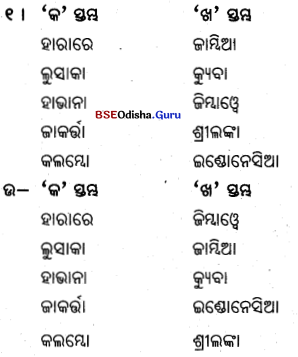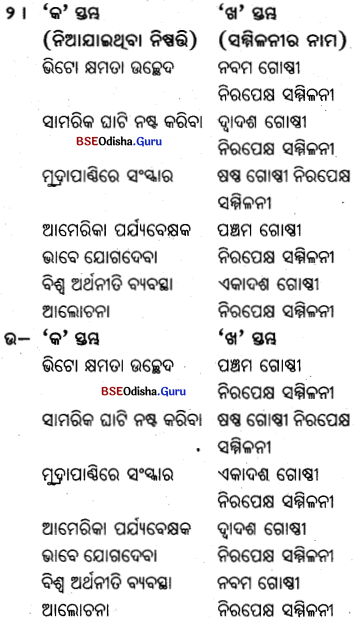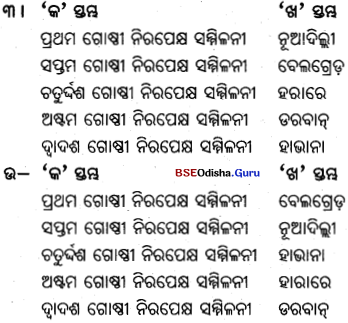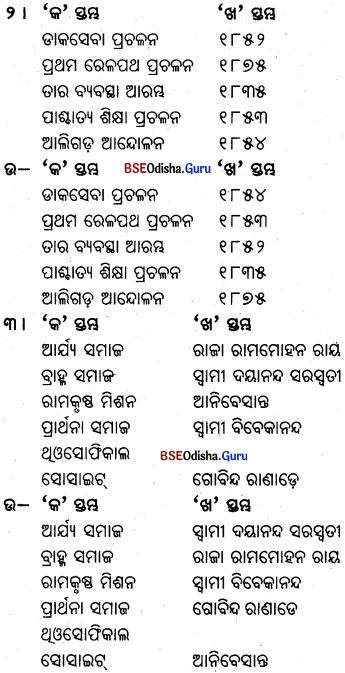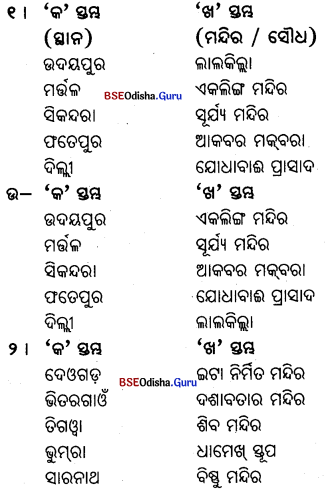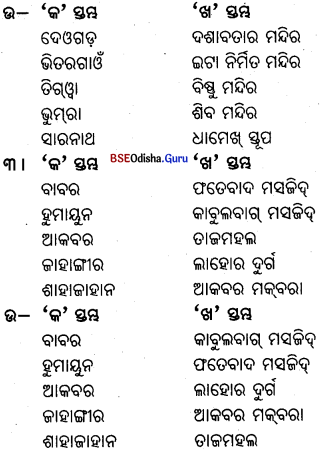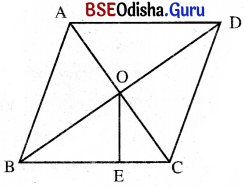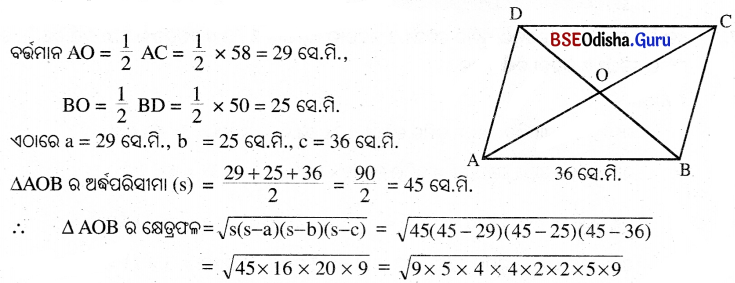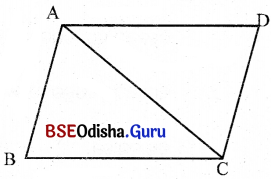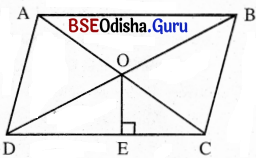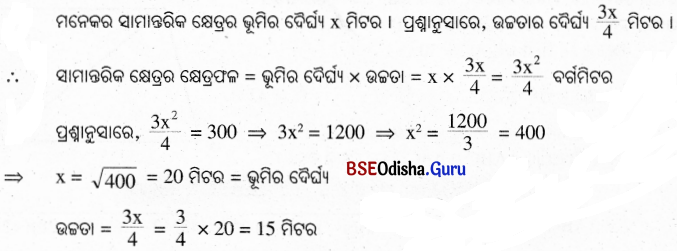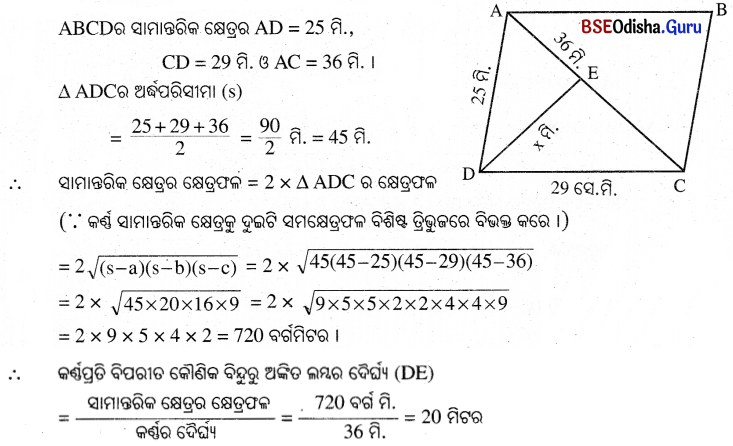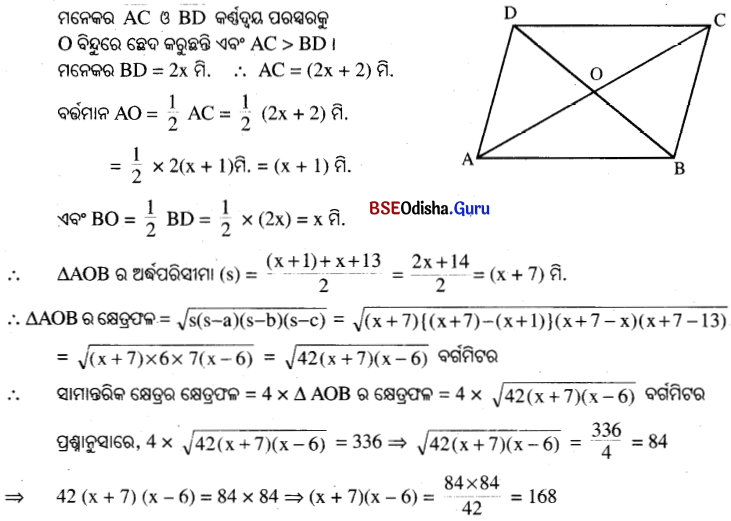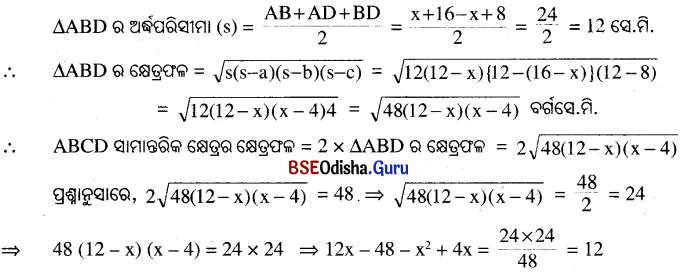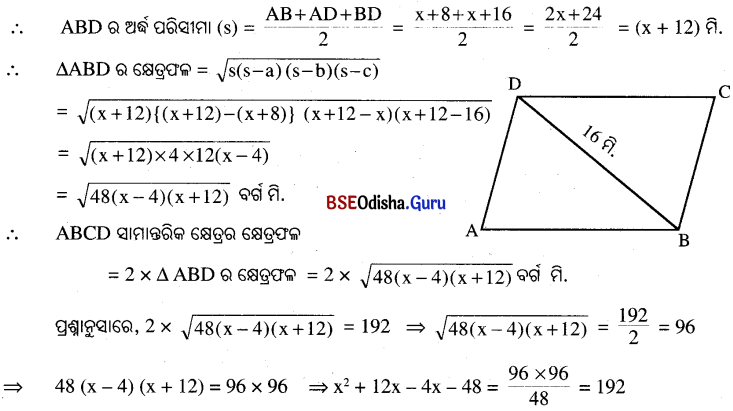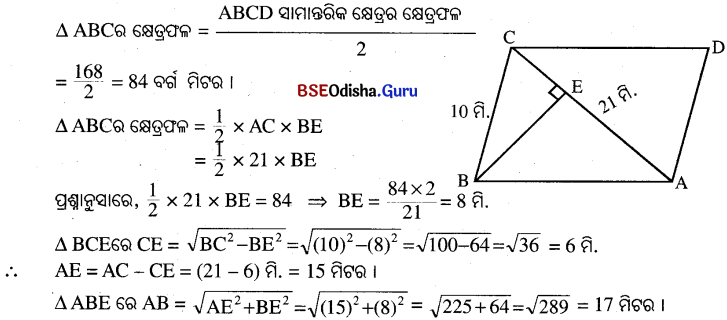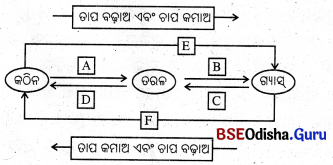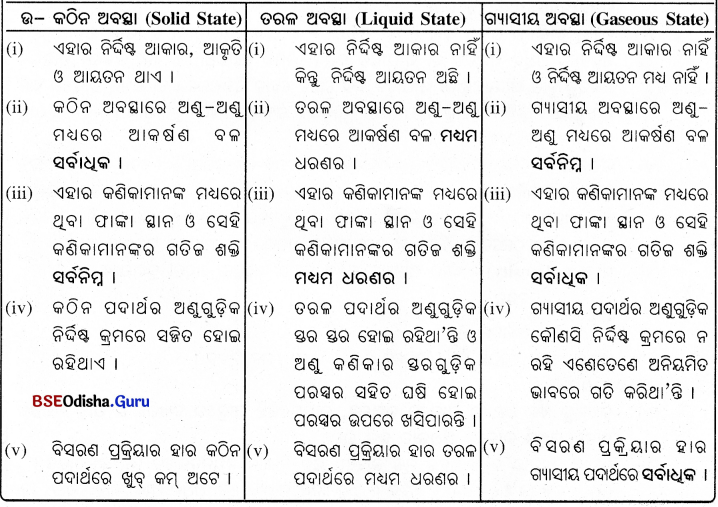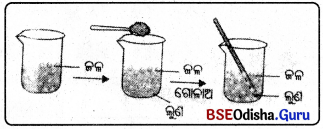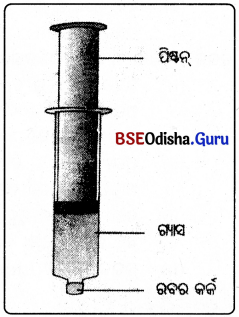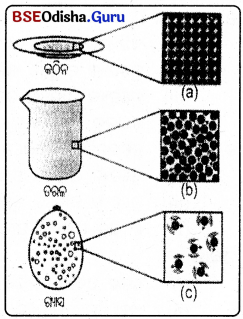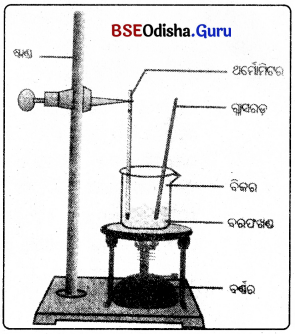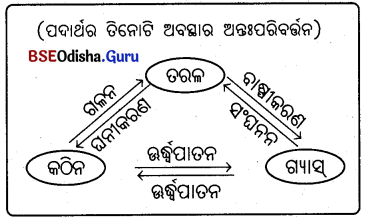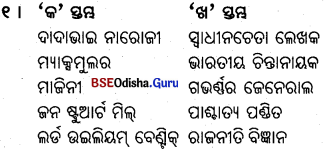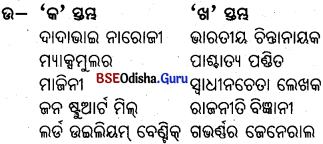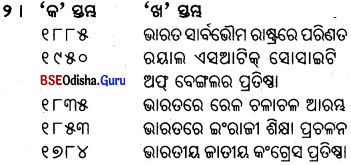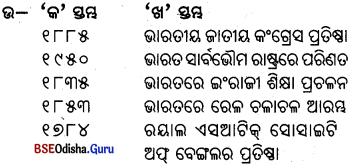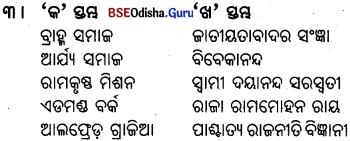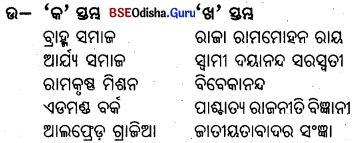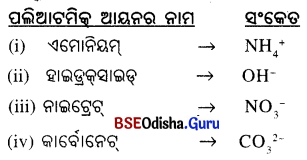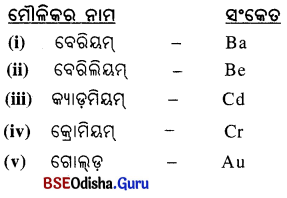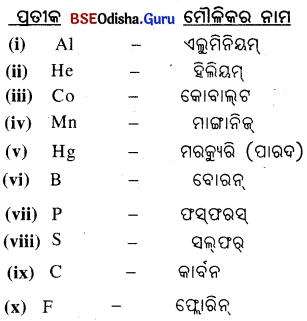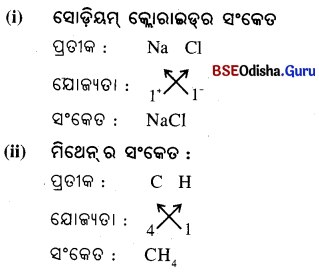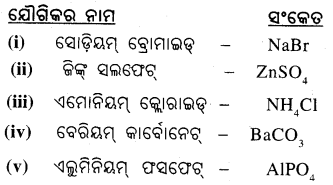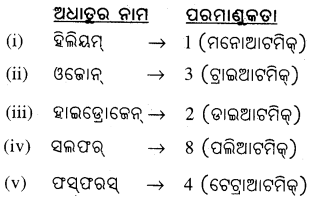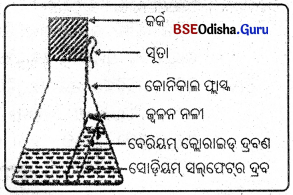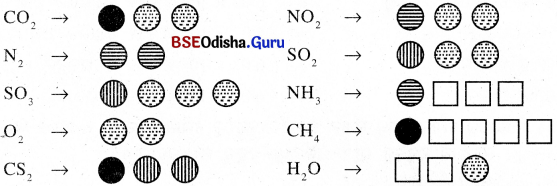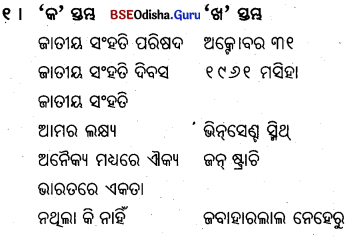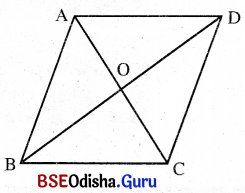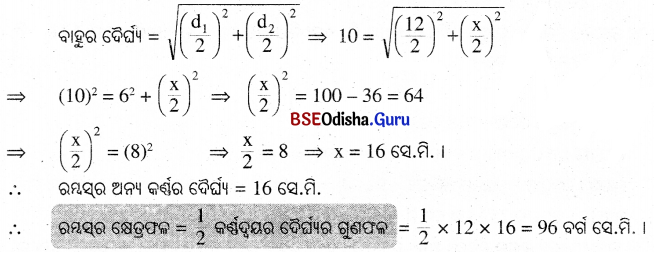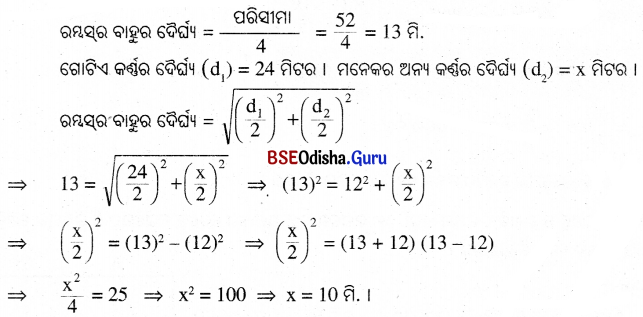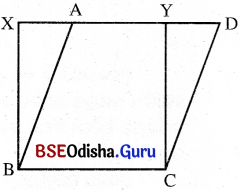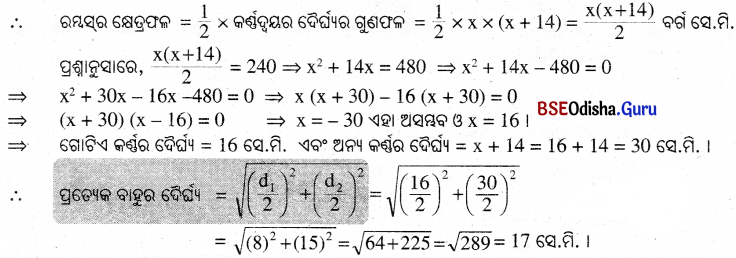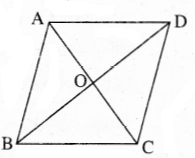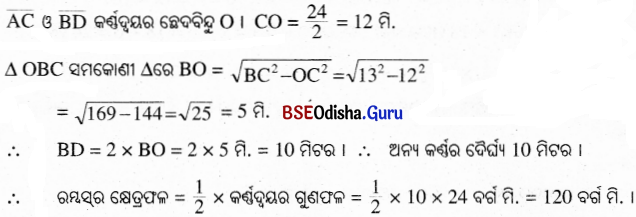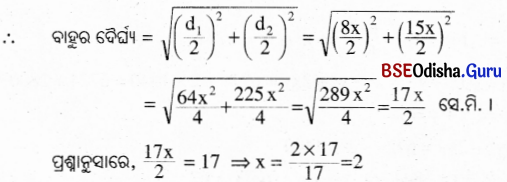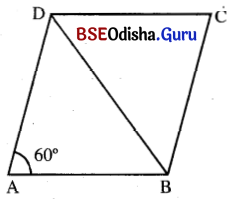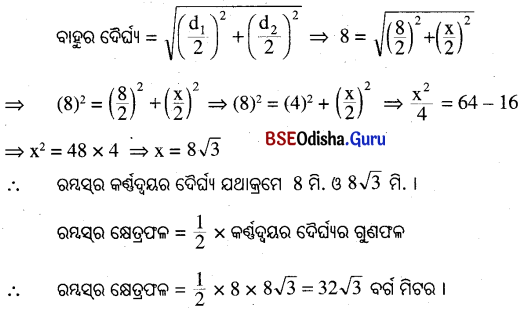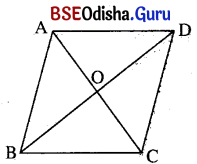Odisha State Board BSE Odisha 10th Class Odia Solutions Chapter 6 ମଙ୍ଗଳେ ଅଇଲା ଉଷା Textbook Exercise Questions and Answers.
BSE Odisha Class 10 Odia Solutions Chapter 6 ମଙ୍ଗଳେ ଅଇଲା ଉଷା
ପାଠ୍ୟପୁସ୍ତକସ୍ଥ ପ୍ରଶ୍ନାବଳୀର ଉତ୍ତର
ସଂକ୍ଷିପ୍ତ ଉତ୍ତରମୂ ଳକ ପ୍ରଶ୍ନୋତ୍ତର
Question ୧।‘ବିକଚ ରାଜୀବ-ଦୃଶା’ ନିମ୍ନୋକ୍ତ କେଉଁ ଅର୍ଥକୁ ବୁଝାଉଛି ?
(କ) ପ୍ରସ୍ଫୁଟିତ ପଦ୍ମଫୁଲ ସଦୃଶ ଆଖୁ ଯାହାର
(ଖ) ପ୍ରସ୍ଫୁଟିତ ପଦ୍ମଫୁଲର ପାଖୁଡ଼ା ସଦୃଶ ଆଖ୍ ଯାହାର
(ଗ) ପ୍ରସ୍ଫୁଟିତ ପଦ୍ମଫୁଲର ସୌନ୍ଦର୍ଯ୍ୟଯୁକ୍ତ ଆଖ୍ ଯାହାର
(ଘ) ପ୍ରସ୍ଫୁଟିତ ପଦ୍ମଫୁଲ ସଦୃଶ ମୁଖ ଯାହାର
Answer:
(କ) ପ୍ରସ୍ଫୁଟିତ ପଦ୍ମଫୁଲ ସଦୃଶ ‘ଆଖ୍ ଯାହାର
Question ୨।
‘ଅରୁଣ କଷାୟ ବାସ’ର ଅର୍ଥ ସ୍ଵରୂପ କେଉଁ ଉକ୍ତିଟି ଠିକ୍ ?
(କ) ଅରୁଣଙ୍କ ନିମନ୍ତେ କଷାୟ ବିସ୍ତ୍ର
(ଗ) ଅରୁଣ ରଙ୍ଗର କଷାୟ ବସ୍ତ୍ର
(ଗ) ଅରୁଣ ରଙ୍ଗର କଷାୟ ବସ୍ତ୍ର
(ଘ) କଷାୟ ରଙ୍ଗର ଅରୁଣ ବସ୍ତ୍ର
Answer:
(ଗ) ଅରୁଣ ରଙ୍ଗର କଷାୟ ବସ୍ତ୍ର
Question ୩ ।
ଉଷାକୁ ପ୍ରଶଂସା କରି ସତୀ ସୀତା କେଉଁ ବାକ୍ୟଟି କହିଛନ୍ତି ?
(କ) ତୁମେ ତିମିର-ବିଧ୍ୱଂସୀ
(ଖ) ତୁମେ ଜାନକୀ-ଦର୍ଶନ ତୃଷାର୍ତ୍ତ
(ଗ) ତୁମେ ପ୍ରଶାନ୍ତ ରୂପ
(ଘ) ତୁମେ ବିକଚ-ରାଜୀବ ଦୃଶା
Answer:
(କ) ତୁମେ ତିମିର ବିଧ୍ୱଂସୀ

Question ୪ ।
ସୀତାଙ୍କର ଅନ୍ୟନାମ ବୈଦେହୀ ହେବାର କାରଣ କ’ଣ ?
(କ) ବିଶେଷ ଦେହଧାରିଣୀ କନ୍ୟା
(ଗ) ଦେହହୀନା କନ୍ୟା
(ଖ) ବିଦେହର କନ୍ୟା
(ଘ) ବିଦେଶିନୀ କନ୍ୟା
Answer:
(ଖ) ବିଦେହର କନ୍ୟା
Question ୫।
ନିମ୍ନଲିଖ ପଦଗୁଡ଼ିକ ମଧ୍ୟରୁ କେଉଁଟି ରୂପକ କର୍ମଧାରୟ ସମାସ ନୁହେଁ ଚିହ୍ନାଇ ଦିଅ ।
(କ) କରପଲ୍ଲବ
(ଖ) ନୀହାରମୁକ୍ତା
(ଗ) ବୀଣାଝଙ୍କାର
(ଘ) ତରଙ୍ଗକର
Answer:
(ଗ) ବୀଣାଝଙ୍କାର
Question ୬ ।
ନିମ୍ନୋକ୍ତ ପ୍ରତ୍ୟେକ ଶବ୍ଦର ଦୁଇଟି ଭିନ୍ନ ଭିନ୍ନ ଅର୍ଥ ଲେଖ ।
ବାସ, ଅଜ୍ଞ, କର, ପଦ, ବନ, ବିଧ, ଶ୍ରୁତି
Answer:
| ଶବ୍ଦ |
ଅର୍ଥ |
ଶବ୍ଦ |
ଗୃହ |
| ବାସ |
ସୁଗକ୍ଷ ବାସ୍ତ |
ବାସ |
ସଂଖ୍ୟା |
| ଅଙ୍କ |
କୋଳ |
ଅଙ୍କ |
ହାତ |
| କର |
ଖଜଣା, ହାଣାଶୁଣ୍ଢ, କିରଣ |
କର |
ଚରଣ |
| ପଦ |
ସମ୍ମାନସୂଚକ ସ୍ଥାନ, କବିତାର ଅନୁଛେଦ |
ପଦ |
କୁଔ |
| ବନ |
ଜଳ, ଅବଶ୍ୟ |
ବନ |
ନିୟମ |
| ବିପ୍ |
ବିଧାତା, ବିଧାନ |
ବିପ୍ |
ହେବ |
| ଶୁତି |
ବର୍ଣ୍ଣ କାନ |
ଶୁତି |
ଗୃହ |
Question ୭।
ନିମ୍ନଲିଖ ଶବ୍ଦଗୁଡ଼ିକର ତିନୋଟି ଲେଖାଏଁ ପ୍ରତିଶବ୍ଦ ଲେଖ ।
କୁସୁମ, ରାଜୀବ, ନୀର, ରାତ୍ରି, ଗଗନ
Answer:
| ଶବ୍ଦ |
ପ୍ରତିଶବ୍ଦ |
| କୁସୁମ |
ସୁମନ, ପ୍ରସନ, ସୁଷ୍ଠ |
| ରାଜାବ |
ତାଙ୍କଜ, ନଳିନୀ, ପହ |
| ନାର |
ଅମ୍ବୁ, ବାରି, ଜଳ |
| ରାତ୍ରି |
ଭଜନା, ଯାମିନୀ, ଶର୍କରା |
| ଗଗନ |
ଥମ୍ବର, ଅନ୍ତରୀକ୍ଷ, ବ୍ୟୋମ |
Question ୮।
‘କ’ ସ୍ତମ୍ଭର ପ୍ରତ୍ୟେକ ପଦ ସହିତ ‘ଖ’ ସ୍ତମ୍ଭର ଉପଯୁକ୍ତ ପଦ ଯୋଗ କର ।
Answer:
| ‘କ’ |
‘ଖ’ |
| ସରସ୍ଵତୀ |
ସ୍ତବପାଠ |
| ମୁକ୍ତା |
ଆଶ୍ରମଧାତ୍ରା |
| ଉଷା |
ପ୍ରଭାତାତାରା |
| କୁମ୍ଭାଟୁଆ |
ଉପହାର |
| ମଙ୍ଗଳ ପ୍ରଦାପ |
ବାଶାଝଙ୍କାର |
| ତମସା |
ସୁକୁମାରଦେହା |
Question ୯।
ବନ୍ଧନୀ ମଧ୍ଯରୁ ଉପଯୁକ୍ତ ଶବ୍ଦ ବାଛି ଶୂନ୍ୟସ୍ଥାନ ପୂରଣ କର ।
(କ) ତୁମ୍ଭ କୋମଳ ଚରଣ କରେ ………………… ଆହରଣା (କିରଣ, ଜ୍ୟୋତି, ରଶି)
(ଖ) ବନ୍ଦିଲେ ଉକ୍ଷାର …………………. ସବିନୟରୋ (ପଦ, ପାଦ, ଚରଣ)
(ଗ) ଜାନକା ଦର୍ଶନ …………………. (ହୃଦ, ତୃଷା, ଆଶା)
(ଘ) ପ୍ରାଙ୍ଗଣେ କୁସୁମ ବିଞ୍ଚି ସୁବାସିତ ………………….. ସିଞ୍ଚା (ନାରି, ଜଳ, ସଲିଳ)
Answer:
(କ) ତୁମ୍ଭ କୋମଳ ଚରଣ କରେ ଜ୍ୟୋତି, ଆହରଣା
(ଖ) ବନ୍ଦିଲେ ଉକ୍ଷାର ପାଦ, ସବିନୟରୋ
(ଗ) ଜାନକା ଦର୍ଶନ ତୃଷା,
(ଘ) ପ୍ରାଙ୍ଗଣେ କୁସୁମ ବିଞ୍ଚି ସୁବାସିତ ନାରି, ସିଞ୍ଚା
କ୍ଷୁଦ୍ର ଉତ୍ତରମୂଳକ ପ୍ରଶ୍ନୋତ୍ତର
Question ୧୦ ।
‘ଦରଶନ ଦିଅ ସତି, ରାତି ପାହିଲା’- ଏକଥା କିଏ କାହାକୁ କହିଛନ୍ତି ?
Answer:
‘ଦରଶନ ଦିଅ ସତି, ରାତି ପାହିଲା’- ଏକଥା ଉଷାରାଣୀ ସତୀ ଶିରୋମଣି ସୀତାଙ୍କୁ କହିଛନ୍ତି ।
Question ୧୧।
ବାଲ୍ମୀକି ଆଶ୍ରମକୁ ଉଷା କାହିଁକି ଆଗମନ କରିଥିଲେ ବୋଲି ବର୍ଣ୍ଣିତ ହୋଇଛି ?
Answer:
ଉଷାରାଣୀ ସତୀ ଶିରୋମଣି ସୀତାଙ୍କୁ ଦର୍ଶନ କରିବାକୁ ବାଲ୍ମୀକି ଆଶ୍ରମକୁ ଆଗମନ କରିଥିଲେ ବୋଲି ବର୍ଣ୍ଣିତ

Question ୧୨ ।
ଉଷା ମଙ୍ଗଳ ମୁହୂର୍ତ୍ତରେ ଆସିଥିବା କଥା କବିତାର କେଉଁ ପଦରୁ ଜଣାପଡ଼ୁଛି ?
Answer:
କବିତାରେ ପ୍ରଥମ ପଦ ‘ମଙ୍ଗଳେ ଅଇଲା ଉଷା……. ରାତି ପାହିଲା’ରୁ ଉଷା ମଙ୍ଗଳମୟ ମୁହୂର୍ତ୍ତରେ ଆସିଥିବା କଥା ଜଣାପଡ଼ୁଛି ।
Question ୧୩ ।
ଉଷା ଉପହାର ସ୍ବରୂପ କ’ଣ ଆଣିଛନ୍ତି ?
Answer:
ଉଷା ଉପହାର ସ୍ବରୂପ ନାହାର ରୂପକ ମୁକ୍ତ। ଆଶିଛନ୍ତ୍ରା
Question ୧୪ ।
ଉଷାଙ୍କ କର ବୋଲି କବି କାହାକୁ କଳ୍ପନା କରିଛନ୍ତି ?
Answer:
ଉଷାଙ୍କ କର ବୋଲି କବି କଅଁଳିଆ ପତ୍ରକୁ କଳ୍ପନା କରିଛନ୍ତି ।
Question ୧୫ ।
ଉଷା କେଉଁ ସ୍ଥାନରେ ରହି ସୀତାଙ୍କୁ ଡାକିଲେ ?
Answer:
ସତୀ ସୀତା ଅବସ୍ଥାନ କରୁଥିବା କୁଟୀର ସମ୍ମୁଖସ୍ଥ ପ୍ରାଙ୍ଗଣରେ ରହି ଉଷା ସୀତାଙ୍କୁ ଡାକିଥିଲେ ।
Question ୧୬ ।
କଳକଣ୍ଠ କଣ୍ଠରେ କିଏ କହିଲା ?
Answer:
ଉଷାଦେବା କଳକଣ୍ତ ବା କୋଇଲି କଶୃରେ କହିଥ୍ ଲୋ
Question ୧୭ ।
ଉଷା କି ପ୍ରକାର ବସ୍ତ୍ର ପିନ୍ଧିଛନ୍ତି ?
Answer:
ଉଷାଦେବା ଲାଳରଙ୍ଗର ପାଟବସ୍ତ ପରିଛନ୍ତି।
Question ୧୮ ।
କବି ଉଷାଙ୍କୁ କେଉଁ ରୂପରେ ବର୍ଣ୍ଣନା କରିଛନ୍ତି ?
Answer:
କବି ଉଷାଙ୍କୁ ଯୋଗେଶ୍ଵରୀ ରୂପରେ ବର୍ଣ୍ଣନା କରିଛନ୍ତି ।

Question ୧୯ ।
ମର୍ତ୍ତ୍ୟଭୁବନକୁ ଉଷା ଆସିବାର ଉଦ୍ଦେଶ୍ୟ କ’ଣ ?
Answer:
ସତୀ ସୀତାଙ୍କର ଦୁଃଖ ଦୂରକରି ତାଙ୍କୁ ନବଜୀବନ ପ୍ରଦାନ କରିବା ହିଁ ଥିଲା ଉଷାଦେବୀଙ୍କର ମର୍ତ୍ତ୍ୟଭୁବନକୁ ଆଗମନର ଉଦ୍ଦେଶ୍ୟ ।
Question ୨୦ ।
ସୀତାଙ୍କୁ ଅଭିନନ୍ଦନ ଜଣାଇବାପାଇଁ ଉଷା କି ବ୍ୟବସ୍ଥାମାନ କରାଇଥିଲେ ?
Answer:
ସୀତାଙ୍କୁ ଅଭିନନ୍ଦନ ଜଣାଇବାପାଇଁ ଉଷାରାଣୀ ସଙ୍ଗୀତ, ନୃତ୍ୟ, ବାଦ୍ୟ ତଥା ସ୍ତୁତିପାଠର ବ୍ୟବସ୍ଥାମାନ
Question ୨୧ ।
ଉଷା ସୀତାଙ୍କୁ ସତୀ ରାଜ୍ୟ-ରାଣୀ ବୋଲି ସମ୍ବୋଧନ କଲେ କାହିଁକି ?
Answer:
ଅଯୋଧ୍ୟା ରାଜ୍ୟର ରାଣୀ ରଘୁକୂଳବଧୂ ସୀତା ହିଁ ଅଗ୍ନିପରୀକ୍ଷା ଦେଇ ସ୍ୱୀୟ ସତୀତ୍ବର ପରାକାଷ୍ଠା ପ୍ରଦର୍ଶନ
Question ୨୨।
ସରସ୍ଵତାଙ୍କ ବାଶାଝଙ୍କାର ସହିତ କାହାକୁ ତୁଳନା କରାଯାଇଚ୍ଛି?
Answer:
ଆଶ୍ରମ ନିବାସୀ ମୁନିମାନଙ୍କ ମୁଖନିଃସୃତ ବେଦଧ୍ଵନି ତଥା ଉଚ୍ଚ ଓଁକାର ଶବ୍ଦକୁ କବି ସରସ୍ଵତୀଙ୍କ ବୀଣାଝଙ୍କାର ସହିତ ତୁଳନା କରିଛନ୍ତି।
Question ୨୩।
ଏହାଦ୍ଵାରା ବନଭୂମିରେ କି ପରିବର୍ତ୍ତନ ଆସିଲା ?
Answer:
ମନ୍ତ୍ରବଳରେ ଶକ୍ତି ବୃଦ୍ଧି ହେବାପରି ଏହାଦ୍ଵାରା ବନଭୂମି କ୍ରମଶଃ ଉଜ୍ଜ୍ବଳ ହୋଇଉଠିଲା ।
Question ୨୪।
ଅନୁକମ୍ପା କିଏ?
Answer:
ବ୍ରହ୍ମଚାରିଣୀ ଅନୁକମ୍ପା ଆଶ୍ରମବାସିନୀ ଜନୈକ ତପସ୍ବିନୀ ।

Question ୨୫।
ଅନୁକମ୍ପା ମାତାଙ୍କୁ କ’ ଣକହିଲେ?
Answer:
ଦର୍ଶନାଭିଳାଷିଶା ଭଷାଙ୍କୁ ଦର୍ଶନ ଦେଇ ସନ୍ତୁଷ୍ଟ କରିବା ସହିବା ସହିତ କୋଳରେ ଧରି ପରମ ସୁଖଲାଭ କରିବାକୁ ଚାହିଁ ରହିଥିବା ତମସାର ଆଶା ପୂର୍ଣ୍ଣ କରିବା ନିମନ୍ତେ ଶଯ୍ୟାତ୍ୟାଗ କରିବା ନିମନ୍ତେ ଅନୁକମ୍ପା ସତୀ ସୀତାଙ୍କୁ କହିଥିଲେ।
Question ୨୬।
ସୀତାଙ୍କ ହୃଦୟରେ ପ୍ରତିବିମ୍ବିତ ବୀର ରାମମୂର୍ତ୍ତିକୁ କବି କାହା ପରି ବୋଲି କହିଛନ୍ତି ?
Answer:
ସାତାଙ୍କ ହୃଦୟରେ ପ୍ରତିବିମ୍ବିତ ବାର ରାମମୁର୍ତ୍ତକୁ କବି ପଦ୍ମନା ହୃଦୟସ୍ଥ ଶିଶିରବିଦୁରେ ପତିତ ସୂର୍ଯ୍ୟଙ୍କର ଖବରଶ୍ମିର ପ୍ରତିଚିମ୍ବି ପରି ବେ।ଲି କହିଛନ୍ତ୍ରା
Question ୨୭।
ସାତାଙ୍କ ହୃଦୟ ଶୋକ – ଜର୍ଜରିତ ହେବାର କାରଣ କ’ଣ?
Answer:
ରପୁବାର ଶ୍ରାରାମଚନ୍ଦ୍ରଙ୍କଦ୍ଵାରା ସାତା ନିର୍ବାସିତା ହୋଇଥ୍ ବାରୁ ତାଙ୍କ ହୃଦୟ ଶୋକ – ଜର୍ଜରିତି ହୋଇଥ୍ ଲା
Question ୨୮।
ସାତା ଉଷାଙ୍କ ପଦବନ୍ଦନା କାର କ’ଣ କହଲେ?
Answer:
ପାତା ଉଷାଙ୍କ ପଦବନ୍ଦନା କରି ତାଙ୍କୁ ସଂସାରରେ ଅସିକାର ବିନାଶିନା ତଥା ସୂର୍ଯ୍ୟୋଦୟର ସୂଚକ ହେବା ପାଇଁ ବହିଥ୍ ଲୋ
Question ୨୯।
ଉଷାଙ୍କୁ ‘ଶୁଭ୍ର ସତ୍ତରଭ ରସିକେ’ ବୋଲି ପାତା କହିଲେ କାହିକି?
Answer:
ଉପାଙ୍କ ଆଗମନରେ ସଂସାର ଶୁଭ୍ର ପୌରଭରେ ପରିପୂର୍ଣ୍ଣ ହୋଇ ଉଠୁଥିବାରୁ ସାତା ତାଙ୍କୁ ‘ଶୁଭ ସଭରଭ ରସିକ’ ବୋଲି କହିଛନ୍ତ୍ରା
Question ୩୦।
‘ଶୁଭ ସମ୍ପାଦିନା ହୁଅ ରଘୁବଂଶିକେ’ – ଏକଥା କିଏ କାହାକୁ କହିଛନ୍ତି?|
Answer:
‘ଶୁଭ ସମ୍ପାଦିନା ହୁଅ ରଘୁବଂଶିକେ’ – ଏକଥା କିଏ କିଏ କାହାକୁ କହିଛନ୍ତି?
Question ୩୧।
ତମସାକୁ ଆଶ୍ରମ ଧାତ୍ରା ବୋଲି କାହିଁକି କୁହାଯାଇଛି?
Answer:
ତମସା ତା’ର ତାରରେ ଅବସ୍ଥିତ ମହର୍ଷି ବାଲୁ।କିଙ୍କ ଆଶ୍ରମର ସମସ୍ତ ଆବଶ୍ୟକତାକୁ ସ୍ୱାୟ ସ୍ୱଚ୍ଛ ପବିତ୍ର ଜଳଦ୍ଵାରା ପୂର୍ଣ୍ଣ କରି ଧାଳନ କରୁଥିବାରୁ ତାକୁ ଆଶ୍ରମ ଧାତ୍ରା ବୋଲି କୁହାଯାଇଛି।

Question ୩୭ ।
ତମସା ନଦା କି କି ଆୟୋଜନ କରି ସତୀ ସାତାଙ୍କର ଆଗମନକୁ ଅପେକ୍ଷା କରିଥିଲେ?
Answer:
ତମସା ନଦୀ ପ୍ରାଙ୍ଗଣରେ କୁସୁମ ବିଞ୍ଚ, ସୁବାସତ ଜଳସଞ୍ଚନ କର, ପ୍ରଭାତା ତାରାକୁ ମଙ୍ଗଳ ପ୍ରଦାପ ରୂପେ ପ୍ରଜ୍ୱଳନ କରି ସାତାଙ୍କର ଆଗମନକୁ ଅପେକ୍ଷା କରିଥ୍ ଲୋ
Question ୩୩ ।
ତମସା ନଦୀ ସୀତାଙ୍କୁ କିପରି ସ୍ଵାଗତ ଜଣାଇଥ୍ଲେ ?
Answer:
ତମସା ନଦୀ ସ୍ବୀୟ ତରଙ୍ଗ ରୂପକ କରକୁ ପ୍ରସାରିତ କରି ସୀତାଙ୍କୁ କୋଳରେ ଧରି ସ୍ନେହାଲିଙ୍ଗନ ପୂର୍ବକ ସ୍ବାଗତ ଜଣାଇଥିଲେ ।
Question ୩୪ ।
ସାତାଙ୍କୁ ଲାଭକରି ତମସା ନିଜକୁ ଭାଗ୍ୟବତା ବୋଲି ଭାବିଛନ୍ତି କାହିଁକି?
Answer:
ସଂସାରର ସତା ଶିରେ।ମଶି ରଘୁକୁଳବଧୂ ଜନକନନ୍ଦିନୀ ସାତାଙ୍କୁ କୋଳରେ ଧରି ସ୍ନେହାଲିଙ୍ଗନ କରିଥିବାରୁ ତମସା ନିଜକୁ ଭାଗ୍ୟବତା ବୋଲି ଭାବିଛନ୍ତି।
ସପ୍ରସଙ୍ଗ ସରଳାର୍ଥ
Question ୩୫ ।
ଦେବା ପାଇଁ ନବ ଜୀବନ
ସ୍ଵଗୁଁ କି ଓହ୍ଲାଇଛନ୍ତି ମର୍ତ୍ତ୍ୟ ଭୁବନ ?
Answer:
ଦେବା ପାଇଁ …………………………… ମର୍ତ୍ତ୍ୟ ଭୁବନ ?
ହୋଇଉଠନ୍ତି । ସଂସାର ବୁକୁରୁ ଦୁଃଖରାଶି ଅପସରି ଯାଇ ଆରମ୍ଭ ହୁଏ ସୁଖଦ ଜୀବନ । ସେହି ଦୁଃଖହାରିଣୀ ନବଜୀବନ ପ୍ରଦାୟିନୀ ଭାଷାରାଣୀ ସତୀ ଶିରୋମଣି ସୀତାଙ୍କୁ ଦର୍ଶନ କରିବାର ଅଭିଳାଷ ନେଇ ମହର୍ଷି ବାଲ୍ମୀକିଙ୍କ ଆଶ୍ରମରେ ସୀତାଙ୍କ ବିଶ୍ରାମ ନେଇଥିବା ସୀତାଙ୍କୁ ରାତି ପାହିବାର ସୂଚନା ଦେଇଛନ୍ତି ।
ମଙ୍ଗଳମୟ ମୁହୂର୍ଭ ବା ବ୍ରାହ୍ମ ମୁହୂର୍ଭକୁ ଉଷାକାଳ କୁହାଯାଏ । ଏହି ଉଷାକାଳ ରାତ୍ରିର ବିଦାୟ ତଥା ସୂର୍ଯ୍ୟୋଦୟର ବାର୍ତ୍ତା ପ୍ରଦାନ କରେ। ରାତ୍ରିକାଳରେ ମୃତ ପ୍ରାୟ ଗତିରହିଥ୍ ବା ଜାବଜଗତ ସୂର୍ଯ୍ୟୋଦୟରେ ନବଜୀବନ ପାଇ ଚଳଚଞ୍ଚଳ ହୋଇଉଠନ୍ତି । ସଂସାର ବୁକୁରୁ ଦୁଃଖରାଶି ଅପସରି ଯାଇ ଆରମ୍ଭ ହୁଏ ସୁଖଦ ଜୀବନ । ସେହି ଦୁଃଖହାରିଣୀ ନବଜୀବନ ପ୍ରଦାୟିନୀ ଭାଷାରାଣୀ ସତୀ ଶିରୋମଣି ସୀତାଙ୍କୁ ଦର୍ଶନ କରିବାର ଅଭିଳାଷ ନେଇ ମହର୍ଷି ବାଲ୍ମୀକିଙ୍କ ଆଶ୍ରମରେ ସୀତାଙ୍କ କୁଟାର ସମ୍ମୁଖସ୍ଥ ପ୍ରାଙ୍ଗଣରେ ଉପସ୍ଥିତ ହୋଇଛନ୍ତି। ରଘୁବାର ଶ୍ରୀରାମଚନ୍ଦ୍ରଙ୍କଦ୍ଵାରା ନିର୍ବାସିତ ହୋଇ ଶୋକସନ୍ତପ୍ତ ଚିତ୍ତରେ ବିଶ୍ରାମ ନେଇଥିବା ସୀତାଙ୍କୁ ରାତି ପାହିବାର ସୂଚନା ଦେଇଛନ୍ତି । ସତେ ଯେପରି କୌଣସି ଯୋଗେଶ୍ଵରୀ ସତୀଙ୍କ ଦୁଃଖରାଶି ଦୂରକରି ତାଙ୍କୁ ନବଜୀବନ ପ୍ରଦାନ କରିବାପାଇଁ ସ୍ବର୍ଗରୁ ମର୍ତ୍ତ୍ୟମଣ୍ଡଳକୁ ଅବତରଣ କରିଛନ୍ତି ଏବଂ ସୀତାଙ୍କ ମନରେ ବିଶ୍ଵାସ ପ୍ରଦାନ କରିବାପାଇଁ ଅମୃତ ମଧୁର ଭାଷାରେ ଆଶ୍ଵାସନାର ବାଣୀ ଶୁଣାଇ ଶଯ୍ୟାତ୍ୟାଗ କରିବାକୁ ଆହ୍ଵାନ କରିଛନ୍ତି। ପ୍ରକୃତି ଉପରେ ମାନବତ୍ଵର ଆରୋପ ତଥା କବିଙ୍କ ଦାର୍ଶନିକ ଦୃଷ୍ଟିକୋଣ ବାସ୍ତବିକ ହୃଦୟସ୍ପର୍ଶୀ ।
Question ୩୬ ।
ବୈକୁଣ୍ଠେ ଦେଇ ତୃପତି ଅନନ୍ତ ଶ୍ରୁତିକି ଗତି
ବିହିଲା କି ସରସ୍ଵତୀ ବୀଣାଝଙ୍କାର ।
Answer:
ବୈକୁଣ୍ଠେ……………….. ବୀଣାଝଙ୍କାର ।
ଉକ୍ତ ପଦ୍ୟାଶଟି ପ୍ରକୃତିକବି ଗଙ୍ଗାଧର ମେହେରଙ୍କଦ୍ଵାରା ପ୍ରଣୀତ ‘ତପସ୍ବିନୀ’ କାବ୍ୟରୁ ସଂଗୃହୀତ ‘ମଙ୍ଗଳେ ଅଇଲା ଉଷା’ ଶୀର୍ଷକ ପଦ୍ୟରୁ ଆନୀତ । ଏଠାରେ କବି ପବିତ୍ର ବେଦମନ୍ତ୍ରର ଉଚ୍ଚାରଣରେ ସମଗ୍ର ବ୍ରହ୍ମାଣ୍ଡ କିପରି ଉଦ୍ବେଳିତ ହୋଇଉଠେ, ତାହା ବର୍ଣ୍ଣନା କରିଛନ୍ତି। ଭାରତବର୍ଷ ମୁନିଋଷିମାନଙ୍କର ଦେଶ । ବେଦ ଏ ଦେଶର ଆଦ୍ୟଗ୍ରନ୍ଥ ତଥା ଜ୍ଞାନର ଉତ୍ସ । ଉଷାକାଳ ଆଗମନରେ ସ୍ବର୍ଗରୁ ମର୍ତ୍ତ୍ୟପର୍ଯ୍ୟନ୍ତ ଯେପରି ଆନ୍ଦୋଳିତ ହୋଇଉଠେ, ସେହିପରି ମୁନିମୁଖ ନିଃସୃତ ସୁସ୍ୱର ବେଦଧ୍ଵନି ତଥା ଉଚ୍ଚ ଓଁକାର ଶବ୍ଦ ଶ୍ୟାମଳ ବନଭୂମିକୁ ମୁଖରିତ କରି ଗଗନ ଭେଦି ବୈକୁଣ୍ଠରେ ବୈକୁଣ୍ଠପତିଙ୍କୁ ପରମତୃପ୍ତି ପ୍ରଦାନ କରିବା ସହ ପୃଥିବୀର ନିମ୍ନସ୍ତରକୁ ମଧ୍ଯ ଗତିକରି ପୃଥିବୀକୁ ମସ୍ତକରେ ଧାରଣ କରିଥିବା ଶ୍ରୁତିଶ୍ରବା ବାସୁକିକୁ ମଧ୍ୟ ଆମୋଦିତ କରେ । ଭାରତବର୍ଷର ପ୍ରାଚୀନ ସଂସ୍କୃତିର ନିଦର୍ଶନ କବିଲେଖନୀରେ ଜୀବନ୍ତ ହୋଇଉଠିଛି ।

Question ୩୭ ।
ଭାଗ୍ୟବତା ମୋତେ ସଂସାରେ
ବୋଲିବେ ତୋ’ ଯୋଗୁଁ ଏକା ପରଶଂସାରେ ।’’
Answer:
ଭାଗ୍ୟବତା ………………….. ଏକା ପରଶଂସାରେ ।’’
ଉକ୍ତ ପଦ୍ୟାଶଟି ସ୍ବଭାବକବି ଗଙ୍ଗାଧର ମେହେରଙ୍କଦ୍ଵାରା ପ୍ରଣୀତ ‘ତପସ୍ବିନୀ’ କାବ୍ୟରୁ ସଂଗୃହୀତ ‘ମଙ୍ଗଳେ ଅଇଲା ଭଷା’ ଶୀର୍ଷକ ପଦ୍ୟରୁ ଆନୀତ । ଏଠାରେ କବି ସତୀଶିରୋମଣି ସୀତାଙ୍କୁ କୋଳରେ ଧରି ତମସା ନଦୀ କିପରି ନିଜକୁ ଭାଗ୍ୟବତୀ ମନେକରିଛି, ତାହା ବର୍ଣ୍ଣନା କରିଛନ୍ତି ।
ପ୍ରକୃତିକବି ପ୍ରକୃତି ଉପରେ ମାନବତ୍ବର ଆରୋପ କରିଛନ୍ତି । ସତୀରାଜ୍ୟ-ରାଣୀ ସୀତା ତମସା ନଦୀତୀରସ୍ଥ ମହର୍ଷି ବାଲ୍ମୀକିଙ୍କ ଆଶ୍ରମରେ ନିର୍ବାସିତା ଜୀବନ ଯାପନ କରିଛନ୍ତି । କବିଙ୍କ ସୂକ୍ଷ୍ମଦୃଷ୍ଟିରେ ସେହି ଆଶ୍ରମର ପାଳନକର୍ତ୍ତୀ ହେଉଛି ତମସା । ଅଯୋଧ୍ୟାର ରାଜଲକ୍ଷ୍ମୀ ଦେବୀ ସୀତା ଭୋଗଲାଳସା ପରିହାର କରି ତା’କୋଳରେ ବିହାର କରିବେ ବୋଲି ସେ କେବେ ମଧ୍ୟ ଆଶା କରି ନଥିଲା । ତେଣୁ ସେ ଅତ୍ୟନ୍ତ ଉତ୍ସାହରେ ରାତ୍ରି ଶେଷରେ ତାଙ୍କୁ ସ୍ବାଗତ କରିବାପାଇଁ ପ୍ରାଙ୍ଗଣରେ ପୁଷ୍ପ ବିଞ୍ଚି, ସୁବାସିତ ନୀର ସିଞ୍ଚନ କରି, ପ୍ରଭାତୀ ତାରାକୁ ମଙ୍ଗଳପ୍ରଦୀପରୂପେ ପ୍ରଜ୍ଜ୍ୱଳନ କରି ସ୍ବୀୟ ମୀନନୟନରେ ତାଙ୍କର ଆସିବା ପଥକୁ ବାରମ୍ବାର ଚାହିଁ ପ୍ରତୀକ୍ଷା କରିଛି । ସତୀରତ୍ନ ସୀତା ମୁନିକନ୍ୟାମାନଙ୍କ ଗହଣରେ ସ୍ନାନ ନିମନ୍ତେ ଯେତେବେଳେ ଆଗମନ କରିଛନ୍ତି, ସେତେବେଳେ ତମସା ତା’ର ତରଙ୍ଗ କରରେ ସତୀଙ୍କୁ କୋଳରେ ଧରି ସ୍ନେହାଲିଙ୍ଗନ କରି ନିଜକୁ ଧନ୍ୟ ମନେକରିଛି । ଦେବୀ ସୀତା ତାକୁ ସେହି ସୌଭାଗ୍ୟ ପ୍ରଦାନ କରିଥିବାରୁ ସଂସାରରେ ସମସ୍ତେ ତାଙ୍କୁ ଭାଗ୍ୟବତୀ କହି ପ୍ରଶଂସା କରିବେ ବୋଲି ସନ୍ତୁଷ୍ଟ ଚିତ୍ତରେ ପ୍ରକାଶ କରିଛି । ବାସ୍ତବିକ ପ୍ରକୃତି କବିଙ୍କ ପ୍ରକୃତି ବର୍ଣ୍ଣନା ଅତ୍ୟନ୍ତ ଜୀବନ୍ତ -ଏହା ନିଃସନ୍ଦେହ ।
Question ୩୮ ।
ଶୁଭ୍ର ସଉରଭ ରସିକେ
ଶୁଭ ସମ୍ପାଦିନୀ ହୁଅ ରଘୁବଂଶିକେ ।
Answer:
ଶୁଭ୍ର – ସତରଭ ………………. .ରଘୁବଂଶିକେ ।
ଭାରତୀୟ ସଂସ୍କୃତିରେ ପତିବ୍ରତା ନାରୀର ସ୍ଥାନ ସବୁଠାରୁ ଊର୍ଦ୍ଧ୍ୱରେ । ସେ ଯେକୌଣସି ସମୟରେ ଯେଉଁ ଅବସ୍ଥାରେ ଥିଲେ ମଧ୍ୟ ନିଜ ପତିଙ୍କର ମଙ୍ଗଳ କାମନା କରିଥାଏ । ସତୀ ଶିରୋମଣି ଦେବୀ ସୀତା ରଘୁବୀରଙ୍କଦ୍ଵାରା ନିର୍ବାସିତା ହୋଇ ବାଲ୍ମୀକିଙ୍କ ଆଶ୍ରମରେ ଅବସ୍ଥାନ କରୁଥିବାବେଳେ ତାଙ୍କ ନିକଟରେ ଉପସ୍ଥିତ ହୋଇଛନ୍ତି ଉଷାରାଣୀ । ଦେବୀ ସୀତା ନମ୍ରତା ପୂର୍ବକ ତାଙ୍କ ପଦବନ୍ଦନା କରି ତାଙ୍କୁ ସଂସାରର ତିମିରବିଧ୍ୱଂସୀ ଓ ସୂର୍ଯ୍ୟୋଦୟର ପ୍ରତୀକ ବୋଲି କହି ପ୍ରଶଂସା କରିଛନ୍ତି । ତାଙ୍କ ଆଗମନରେ ସଂସାର ଶୁଭ୍ରଜ୍ୟୋତିରେ ଉଦ୍ ଭାସିତ ହେବ।ସହ ସୌରଭରେ ହେଇଠେ ଆମେ।ଦିତା ଚତୁର୍ଦିଗରେ ଭରିଯାଏ ପବିତ୍ରତାର ବାତାବରଣ । ସେହି ସମୟ ହିଁ ସଂସାରରେ ଶୁଭମୁହୂର୍ଣଭାବେ ହୋଇଛି ବିଦିତ । ତେଣୁ ସେହି ମଙ୍ଗଳପ୍ରଦାୟିନୀ ଉଷାରାଣୀ ନିଶ୍ଚିତ ମଙ୍ଗଳ ବିଧାନ କରିବାର ଦୃଢ଼ ଆଶା ହୃଦୟରେ ପୋଷଣ କରି ପତିବ୍ରତା ସୀତା ତାଙ୍କ ଚରଣରେ ଶରଣ ଏହା ହିଁ ଭାରତୀୟ ନାରୀର ମହନୀୟତା ଯାହା କବିଙ୍କ ଲେଖନୀରେ ହୋଇଛି ରୂପାୟିତ ।
ଦୀର୍ଘ ଉତ୍ତରମୂଳକ ପ୍ରଶ୍ନୋତ୍ତର
Question ୩୯ ।
ପଠିତ କବିତା ଅନୁସରଣରେ ବାଲ୍ମୀକି ଆଶ୍ରମରେ ପ୍ରଭାତକାଳୀନ ପ୍ରାକୃତିକ ସୌନ୍ଦର୍ଯ୍ୟ ବର୍ଣନା କର । କିମ୍ବା, ବାଲ୍ମୀକି ଆଶ୍ରମର ପ୍ରଭାତକାଳୀନ ଦୃଶ୍ୟ କବିଙ୍କ ଲେଖନୀରେ କିପରି ରସପୂର୍ଣ୍ଣ ଓ ଜୀବନ୍ତ ହୋଇପାରିଛି ଆଲୋଚନା କର । କିମ୍ବା, ଉଷାର ଆଗମନରେ ବାଲ୍ମୀକିଙ୍କ ଆଶ୍ରମପ୍ରକୃତି କିପରି ଅପୂର୍ବ ଶୋଭା ଧାରଣ କରିଛି, ତାହା ପଠିତ କବିତା ଆଧାରରେ ଆଲୋଚନା କର। କବିତା ଆଧାରରେ ଆଲୋଚନା କରା
Answer:
ଆଧୁନିକ ଓଡ଼ିଆ କାବ୍ଯସାହିତ୍ୟର ଅମରସ୍ରଷ୍ଟା ସ୍ଵଭାବକବି ଗଙ୍ଗାଧର ମେହେରଙ୍କ ଶାଶ୍ଵତ ସୃଷ୍ଟିନିଚୟ, ତାଙ୍କ ଅନିର୍ବଚନୀୟ କବିପ୍ରତିଭାର ଯଥାର୍ଥ ପରିଚୟ ପ୍ରଦାନ କରେ । ପ୍ରକୃତିକୁ ଜୀବନ୍ତ ସତ୍ତାରେ ରୂପାନ୍ତରିତ କରି ପାଠକ ସମ୍ମୁଖରେ ପ୍ରକାଶ କରାଇବାର କଳାକୌଶଳ ତଦୀୟ ନୈସର୍ଗିକ ପ୍ରତିଭାର ପରିଚାୟକ । କବିଙ୍କର ‘ତପସ୍ବିନୀ’, ‘ପ୍ରଣୟବଲ୍ଲରୀ’, ‘ଅହଲ୍ୟାସ୍ତବ’, ‘କୀଚକ ବଧ’, ‘ପଦ୍ମିନୀ’, ‘ଇନ୍ଦୁମତୀ’ କାବ୍ୟସମୂହ ଏବଂ ‘ଅର୍ଘ୍ୟଥାଳୀ’ ଓ ‘କବିତା କଲ୍ଲୋଳ’ ପ୍ରଭୃତି କ୍ଷୁଦ୍ର କବିତା ସଙ୍କଳନ କବିଙ୍କ ଅମ୍ଳାନ ପ୍ରତିଭାର ସ୍ମାରକୀ ରୂପେ ଅଦ୍ୟାବଧୂ ଜନମାନସରେ ପ୍ରତିବିମ୍ବିତ । ‘ତପସ୍ବିନୀ’ କାବ୍ୟର ଚତୁର୍ଥ ସର୍ଗରୁ ସଂଗୃହାତ ‘ମଙ୍ଗଳେ ଅଇଲା ଉକ୍ଷା’ ଶାର୍ଷକ କବିତାରେ କବି ବାଲ୍ଲାକି ଆଶ୍ରମରେ ପ୍ରଭାତକାଳାନ ପ୍ରାକୃତିକ ଦୃଶ୍ୟରାଜିକୁ ଜୀବନ୍ତ ଭାବେ ଉପସ୍ଥାପନ କରିଛନ୍ତି ।
ଶାନ୍ତ-ସୁନ୍ଦର, ସ୍ନିଗ୍ଧ -ମଧୁର ଆଶ୍ରମର ତପୋବନ ମଧ୍ୟରେ ଉଷାର ଆବିର୍ଭାବକୁ ପ୍ରକୃତି ପୂଜାରୀ କବି ସତେଯେପରି ସମସ୍ତ ଅଶୁଭର ଅନ୍ତ ଘଟାଇ ଓ ମଙ୍ଗଳବାର୍ତ୍ତା ବାହିକା ଭାବେ ଆଶ୍ରମ ଉପବନରେ ଉପଗତା ହୋଇଛି । ଉଷା-ପ୍ରକୃତି ଚିତ୍ରଣରେ କବି ମାନବୋଚିତ ଲକ୍ଷଣର ଆରୋପଣ କରିଛନ୍ତି । ସତୀ ସୀତାଙ୍କୁ ଉପହାର ଦେବାପାଇଁ କରପଲ୍ଲବରେ ନୀହାର-ମୁକ୍ତାର ଅଞ୍ଜଳି ଧରି ଆଶ୍ରମ ପ୍ରାଙ୍ଗଣରେ ଉପସ୍ଥିତ ହୋଇଛି ଉଷା । ବାଳାରୁଣ ବର୍ଷପ୍ରାୟ ଗୈରିକ ବସ୍ତ୍ର ବିମଣ୍ଡିତ, ପ୍ରଶାନ୍ତବଦନା, ସଦ୍ୟ ପ୍ରସ୍ଫୁଟିତ ପୁଷ୍ପରାଗ କାନ୍ତି ବିଶିଷ୍ଟା ଉଷା ଯୋଗେଶ୍ଵରୀ ରୂପରେ ସତେ ଯେପରି ସ୍ବର୍ଗାବତରଣ କରିଛନ୍ତି। କୋକିଳର ସୁମଧୁର ସ୍ୱରରେ ରାତ୍ରି ଅବସାନର ସୂଚନା ଦେଇ ସୀତାଙ୍କୁ ଶଯ୍ୟାତ୍ୟାଗ କରିବାକୁ ସେ ଆହ୍ଵାନ କରିଛନ୍ତି ।
ମୃଦୁମନ୍ଦ ପ୍ରଭାତକାଳୀନ ଶୀତଳ ସମୀରଣ ମଙ୍ଗଳ ସଙ୍ଗୀତ ଗାନ ଆରମ୍ଭ କରିଛି । ଭ୍ରମରକୁଳ ବୀଣାବାଦନ କରି ସଙ୍ଗୀତରେ ସୁସଂଯୋଜିତ ହୋଇଛି । କୁମ୍ଭାଟୁଆ ଭାଟ ବେଶରେ ସ୍ତବ ପାଠ କରିଛି । ଶ୍ରେଷ୍ଠ ସ୍ତୁତିପାଠକାରୀ ସାଜି କଜଳପାତି ସତୀଙ୍କ ଦ୍ୱାରଦେଶରେ ତାଙ୍କର ଗୁଣଗାନ କରିଛି ଓ ମଧୁର ସ୍ବରରେ ରାଜ୍ୟରାଣୀଙ୍କୁ ପହୁଡ଼ ଭାଙ୍ଗିବାକୁ ଆହ୍ୱାନ କରିଛି । କବିଙ୍କ ଭାଷାରେ-
“କଳିଙ୍ଗ ଅଇଲା ପାଟ ମାଗଧ ବେଶେ,
ଲଳିତ ମଧୁରେ କହିଲା,
ଉଠ ସତା ରାଜ୍ୟ – ରାଶା, ରାତି ପାହିଲା”
ବ୍ରାହ୍ମ ମୁହୂର୍ତ୍ତରୁ ଶ୍ୟାମଳ ଲତାକୁଞ୍ଜ ପରିବେଷ୍ଟିତ ଆଶ୍ରମ ଉପବନ ମୁନିମୁଖନିଃସୃତ ବେଦର ଓଁକାର ଧୃବର ହୋଇଉଠିଛି ପ୍ରତିଧ୍ଵନିତ । ସେହି ପବିତ୍ର ବେଦମନ୍ତ୍ର ଧ୍ୱନିର ଉଚ୍ଚ ଓଁକାର ପ୍ରଭାବରେ ସମଗ୍ର ବନଭୂମି କ୍ରମଶଃ ଉତ୍କଳ ହୋଇଉଠିଛି । ଆଶ୍ରମ ପାର୍ଶ୍ଵରେ ପ୍ରବହମାନା ତମସା ନଦୀ ମଧ୍ୟ ସତୀଙ୍କୁ କୋଳାଗ୍ରତ କରିବାପାଇଁ ଆଶ୍ରମ ପ୍ରାଙ୍ଗଣରେ ସୁବାସିତ ପୁଷ୍ପ ବିଦେଇ ଓ ସୁବାସିତ ଜଳ ସିଞ୍ଚନ କରି ପ୍ରଭାତୀତାରାକୁ ମଙ୍ଗଳଦୀପ ଭାବେ ଧାରଣ କରି ପ୍ରତୀକ୍ଷା କରିଛି । ପ୍ରକୃତି ମଧ୍ୟରେ ପ୍ରାଣସତ୍ତା ଭରିଦେଇ ତାକୁ ମାନବଚରିତ୍ର ଭାବେ ଉପସ୍ଥାପନ କରିବାରେ ସ୍ଵଭାବକବିଙ୍କ ଲେଖନୀ ଯେଉଁ ଚମତ୍କାରିତା ‘ପ୍ରଦାନ କରିଛି ତାହା ଅନନ୍ୟ ଓ ଅନୁପମ ।

Question ୪୦ ।
ଆଶ୍ରମରେ ସତୀ ସୀତାଙ୍କୁ ଉଷା କିମ୍ବା, ଦେବୀ ସୀତାଙ୍କ ପାଇଁ ଉଷାଦେବୀ ବର୍ଣ୍ଣନା କର । କିମ୍ବା, ଦେବୀ ସୀତାଙ୍କ ପାଇଁ ଉଷାଦେବୀ କରିଥିବା ରାଜକୀୟ ସ୍ଵାଗତ ସମ୍ବର୍ଣନାର ଆୟୋଜନ ସମ୍ପର୍କରେ ବର୍ଣ୍ଣନା କରା କିମ୍ବା, ମହର୍ଷି ବାଲ୍ମୀକିଙ୍କ ଆଶ୍ରମରେ ସତୀ ସୀତାଙ୍କୁ ଉଷାଦେବୀ କିପରି ସ୍ଵାଗତ ଜଣାଇଛନ୍ତି, ପଠିତ କବିତା ଆଧାରରେ ଆଲୋଚନା କର ।
Answer:
ଉତ୍କଳ ଭାରତୀଙ୍କ ବରପୁତ୍ର ସ୍ବଭାବକବି ଗଙ୍ଗାଧର ମେହେର ଏକାଧାରରେ ଥିଲେ ଅମ୍ଳାନ ପ୍ରତିଭାବନ୍ତ କାବ୍ୟଶିଳ୍ପୀ, ପ୍ରକୃତିବାଦୀ, ସୌନ୍ଦର୍ଯ୍ୟପିପାସୁ, ସ୍ଵଦେଶପ୍ରେମୀ, ଯୁଗସଚେତକ ତଥା ସମନ୍ଵୟାତ୍ମକ ସାରସ୍ଵତ ସ୍ରଷ୍ଟା । ଭାଷାସୌନ୍ଦର୍ଯ୍ୟ, ଭାବଗାମ୍ଭୀର୍ଯ୍ୟ, ତଥା ଅନ୍ତଃ ସୌନ୍ଦର୍ଯ୍ୟଭରା ପ୍ରତ୍ୟେକଟି ସାରସ୍ଵତ ସୃଷ୍ଟିରୁ ତାଙ୍କ ପ୍ରଜ୍ଞାର ଐଶ୍ବର୍ଯ୍ୟମୟ ଆଭାସ ସୁସ୍ପଷ୍ଟ । କବିଙ୍କ ସୃଷ୍ଟିନିଚୟ ମଧ୍ୟରେ ‘ତପସ୍ବିନୀ’, ‘ପ୍ରଣୟବଲ୍ଲରୀ’, ‘କୀଚକବଧ’, ‘ଇନ୍ଦୁମତୀ’, ‘ପଦ୍ମିନୀ’, ‘ଅଯୋଧ୍ୟା ଦୃଶ୍ୟ’ ତଥା ‘ଉତ୍କଳଲକ୍ଷ୍ମୀ’ ଆଦି କାବ୍ୟସମୂହ ତଥା କ୍ଷୁଦ୍ରଗୀତ ସଂକଳନ ମଧ୍ଯରେ ‘ଅର୍ଘ୍ୟଥାଳୀ’, ‘କୃଷକ ସଙ୍ଗୀତ’, ‘କବିତାମାଳା’ ଓ ‘କବିତା କଲ୍ଲୋଳ’ ଆଦି କବିଙ୍କ ଅମ୍ଳାନ ପ୍ରତିଭାର ପରିଚୟ ପ୍ରଦାନ କରେ ।
ପ୍ରକୃତିକୁ ମାନବଚରିତ୍ର ଭଳି ଉପସ୍ଥାପନ କରିବାରେ କବି ଗଙ୍ଗାଧରଙ୍କ ସିଦ୍ଧହସ୍ତତା ପ୍ରଣିଧାନଯୋଗ୍ୟ । ସତୀ ସୀତା ଗଭୀର ଅନ୍ତର୍ବେଦନା ଓ ବିଷାଦିତ ପ୍ରାଣରେ ରାତ୍ରିଯାପନ କରିବା ପରେ ନବପ୍ରଭାତରେ ଶାନ୍ତ-ଶୀତଳ, ସ୍ନିଗ୍ଧ-ମଧୁର ବାଲ୍ମୀକି ଆଶ୍ରମ ଓ ତତ୍-ସଂଲଗ୍ନ ତପୋବନରେ ଉଷା ଆବିର୍ଭୂତା ହୋଇଛି ସତୀମାତାଙ୍କୁ ସ୍ବାଗତ କରିବାପାଇଁ । ପ୍ରତ୍ୟକ୍ଷଦର୍ଶୀ ସାଜି ପ୍ରକୃତି ପୂଜାରା କବି ନାବାନ ରକ୍ଷାର ମାଧୁର୍ଯ୍ୟକୁ ଆକଣ୍ଠ ପାନ କରିଛନ୍ତି। କବି କଳ୍ପନାରେ ସମସ୍ତ ମାନବାୟ ଗୁଣରେ ଭୂଷିତ । ଉଷା ଜଣେ ସହୃଦୟ, ସମ୍ବେଦନଶୀଳା ନାରୀଭାବେ ଆବିର୍ଭୂତା ହୋଇଛି ଆଶ୍ରମ ପରିବେଶରେ । ଜଗନ୍ମାତା ସୀତାଙ୍କୁ ଦର୍ଶନ କରିବାର ଅଭିଳାଷ ନେଇ ଉପହାର ହସ୍ତରେ ଉଷା ଅପେକ୍ଷା କରିଛନ୍ତି ସତୀଙ୍କ ବାସ ବାହାର ପ୍ରାଙ୍ଗଣରେ ।
ସର୍ବମଙ୍ଗଳମୟତାର ସୂଚନା ପ୍ରଦାନ କରି ମଙ୍ଗଳମୟ। ଉଷା ବିକଶିତ ପଦ୍ମପୁଷ୍ଠର ସୌନ୍ଦର୍ଯ୍ୟରେ ସୁଦୃଶା ହୋଇ ଆଶ୍ରମ ପ୍ରାଙ୍ଗଣରେ ସତୀମାତା ସୀତାଙ୍କ ଦର୍ଶନପିପାସା ଚରିତାର୍ଥ କରିବା ଉଦ୍ଦେଶ୍ୟରେ ଅପେକ୍ଷା କରିଛନ୍ତି । ସୀତାଙ୍କୁ ଉପହାର ଦେବାପାଇଁ ତାଙ୍କ କରିଥିଲ୍ଲାପରେ ରହିଛି ନାହାର – ମୁକ୍ତାର ଅଞ୍ଚଳି । ଶ୍ରୁତି – ସୁଖଦାୟ୍। କୋକିଳର କୋମଳ – ମଧୁର କୁହୁତାନରେ ସତୀଙ୍କୁ ନିଦ୍ରାଭଙ୍ଗ କରିବାପାଇଁ ଆହ୍ଵାନ କରିଛନ୍ତି ସେ । ଉଷାଙ୍କ ଉପସ୍ଥିତିରେ ଆଶ୍ରମ ପ୍ରକୃତି ବେଦମାତ୍ତ୍ୱିକ ହୋଇଉଠିଛି । ଅରୁଣ- ରାଗ – ରଞ୍ଜିତ ଗୌରିକ ବସ୍ତାବୃତା ଉଷା ସ୍ଵର୍ଗପୁର।ରୁ ମର୍ତ୍ତ୍ୟାଗତରଣ କରିଥିବା ଜଣେ ଯୋଗେଶ୍ଵରା ପ୍ରାୟ ରୂପଲାବଣ୍ୟରେ ଉଦ୍ଭାସିତା ହୋଇଉଠିଛନ୍ତି । ଶରୀରର କାନ୍ତରେ ସଦ୍ୟପୁଷ୍ପର ରାଗ, ମୁଖମଣ୍ଡଳରେ ଅଖଣ୍ଡ ପ୍ରଶାନ୍ତି ବହନ କରିଥିବା ଉଷା ସତୀସୀତାଙ୍କ ଶୋକ ଜର୍ଜରିତ ଚିତ୍ତରେ ନବୀନ ଆଶା ଭରିଦେବା ପାଇଁ ପ୍ରତୀକ୍ଷା କରିଛନ୍ତି । ନବୀନ ତପସ୍ବିନୀ ଜୀବନର ଅୟମାରମ୍ଭ କରିବାପାଇଁ ପରିପାର୍ଶ୍ବରେ ସମସ୍ତ ମାଙ୍ଗଳିକ ଆୟୋଜନ କରିଛନ୍ତି ସେ । କବିଙ୍କ ଭାଷାରେ-
“ସମାର ସଙ୍ଗୀତ ଗାଏ ଭ୍ରମର ବାଣା ବଜାଏ
ସୁରଭି ନର୍ତ୍ତନେ ଥାଏ ଉଷା ନିର୍ଦ୍ଦେଶ
କୁମ୍ଭାଟୁଆ ହୋଇ ଭାଟ ଆରମ୍ଭିଲା ସ୍ତବପାଠ
କଳିଙ୍ଗ ଅଙ୍ଗଲା ପାଟ ମାଗଧ ବେଶେ ।”
ଜଣେ ଦକ୍ଷ ନିର୍ଦ୍ଦେଶିକା ଭାବେ ସ୍ବାଗତ ସମ୍ବର୍ଦ୍ଧନା ପର୍ବର ସଫଳ ରୂପାୟନ ପାଇଁ ଉଷା ମନପ୍ରାଣ ଢାଳି ଦେଇଛନ୍ତି । ମୃଦୁମନ୍ଦ ସମୀରଣ ସ୍ଵାଗତ ଗୀତିକା ଗାନ କରିଛି । ଭ୍ରମରକୁଳ ବୀଣାବାଦନ କରି ସେହି ସଙ୍ଗୀତରେ ସ୍ବର ମିଶ୍ରଣ କରିଛନ୍ତି । ଛନ୍ଦ ତୋଳି ସୁରଭି ନୃତ୍ୟ ଆରମ୍ଭ କରିଦେଇଛି । କୁମ୍ଭାଟୁଆ ଭାଟ ଭୂମିକାରେ ସ୍ତବପାଠ କରୁଥିଲାବେଳେ କଜଳପାତି ଶ୍ରେଷ୍ଠ ସ୍ତୁତିପାଠକାରୀ ଭାବେ ସତୀଙ୍କ ଗୁଣ କୀର୍ତ୍ତନ କରିଛି ଓ ଲଳିତ ମଧୁର ସ୍ଵରରେ ସତୀଙ୍କୁ ଶଯ୍ୟାତ୍ୟାଗ କରିବାକୁ ଅନୁରୋଧ କରିଛନ୍ତି । କବିଙ୍କ ଭାଷାରେ-
“କଳିଙ୍ଗ ଅଇଲା ପାଟ ମାଗଧ ବେଶେ,
ଲଳିତ ମଧୁରେ କହିଲା,
ଉଠ ସତା ରାଜ୍ୟ – ରାଶା ରାତି ପାହିଲା ।”
ସତୀ ସୀତାଙ୍କୁ ସ୍ବାଗତ କରିବାପାଇଁ ଉଷାଙ୍କର ସକଳ ଆୟୋଜନ ଆଶ୍ରମର ଶାନ୍ତ-ପବିତ୍ର, ଅମୃତମୟ ମନୋହର ବାତାବରଣରେ ମଞ୍ଜୁଳତା ଭରିଦେଇଛି । କବିଙ୍କ ଲେଖନୀରେ ସତେଯେପରି ସମଗ୍ର ପ୍ରକୃତି ଜୀବନ୍ତ ମାନବୀୟ ରୂପ ଧରି ପାଠକ ସମ୍ମୁଖରେ ଉଭା ହୋଇଛି।
Question ୪୧ ।
ପଠିତ କବିତାରୁ କବିଙ୍କର ପ୍ରକୃତି ଚିତ୍ରଣର ବିଶେଷତ୍ଵ ଲେଖ ।
କିମ୍ବା, ‘ମଙ୍ଗଳେ ଅଇଲା ଉଷା’ – କବିତାରୁ ଗଙ୍ଗାଧରଙ୍କ ପ୍ରକୃତି ପ୍ରେମର ଉଦାହରଣ ପ୍ରଦର୍ଶନ କର ।
Answer:
ଆଧୁନିକ ଓଡ଼ିଆ କାବ୍ୟସାହିତ୍ୟକୁ ସ୍ଵାୟୁ ପ୍ରତିଭା ପ୍ରଭାରେ ସମୁଦ୍ଭାସିତ କରିବାରେ ସ୍ଵଭାବକବି ଗଙ୍ଗାଧର ମେହେରଙ୍କ ଅସାଧାରଣ କଳାନୈପୁଣ୍ୟ ସର୍ବଜନସ୍ବୀକାର୍ଯ୍ୟ । ତାଙ୍କ ଅମ୍ଳାନ କବିପ୍ରତିଭାର ସ୍ମାରକୀ ଭାବେ ‘ତପସ୍ବିନୀ’, ‘ପ୍ରଣୟବଲ୍ଲରୀ’, ‘ଇନ୍ଦୁମତୀ’, ‘ପଦ୍ମିନୀ’, ‘କୀଚକବଧ’, ‘ଅଯୋଧ୍ୟା ଦୃଶ୍ୟ’ ଓ ‘ଉତ୍କଳଲକ୍ଷ୍ମୀ’ ପ୍ରଭୃତି କାବ୍ୟସମୂହ ତଥା ‘କୃଷକ ସଙ୍ଗୀତ’, ‘କବିତାମାଳା’, ‘କବିତା କଲ୍ଲୋଳ’ ଓ ‘ଅର୍ଘ୍ୟଥାଳୀ’ ଆଦି କ୍ଷୁଦ୍ର ଗୀତ ସଙ୍କଳନ ଉତ୍କଳ ସାହିତ୍ୟ ଭଣ୍ଡାରର ଅମୂଲ୍ୟ ରତ୍ନତୁଲ୍ୟ ଚିର ଦେଦୀପ୍ୟମାନ ।
କବିତା ‘ମଙ୍ଗଳେ ଅଇଲା ଉଷା’ କବିଙ୍କର ଶ୍ରେଷ୍ଠ କୃତି ‘ତପସ୍ବିନୀ’ କାବ୍ୟର ଚତୁର୍ଥ ସର୍ଗରୁ ସଂଗୃହୀତ କାବ୍ୟଂଶ । ରାଜ୍ମାକି ଆଶ୍ରମରେ ନିର୍ବାସିତ ସତ। ମାତା ଜାନକାଙ୍କୁ ପ୍ରକୃତିର ସ୍ୱାଗତ ସମ୍ଭାଷଣ କରିଙ୍କ ଲେଖନୀମୁନରେ କାରନ୍ତି ହୋଇଉଠିଛି। ପ୍ରକୃତିକୁ ମାନବ ଚରିତ୍ର ଭାବେ ଉପସ୍ଥାପନ କରିବାରେ କବି ଗଙ୍ଗାଧରଙ୍କ ସିଦ୍ଧହସ୍ତତା କବିତାର ଛତ୍ରେ ଛତ୍ରେ ପ୍ରତିଫଳିତ ହୋଇଛି । ଜଡ଼ ପ୍ରକୃତିରେ ଜୀବନ୍ୟାସ କରି ତାକୁ କ୍ରିୟାଶୀଳ କରିବାରେ କବି ତାଙ୍କ ସୃଷ୍ଟିସମୂହରେ ଯେଉଁ ଶାବ୍ଦିକ ମାୟା ରଚନା କରିଛନ୍ତି ତାହା ଅନ୍ୟ କୌଣସି କାବ୍ୟ କବିତାରେ ପରିଦୃଷ୍ଟ ହୁଏ ନାହିଁ ।
ପତିକର୍ତ୍ତୃକ ନିର୍ବାସିତା ଅଯୋଧ୍ୟା ରାଜଲକ୍ଷ୍ମୀ, ସତୀ ସୀତାଙ୍କ ପ୍ରତି ନିର୍ବିଚାର ଦଣ୍ଡବିଧାନ ବିରୁଦ୍ଧରେ ପ୍ରକୃତି ହିଁ ଦୃଢ଼ ସ୍ଵର ଉତ୍ତୋଳନ କରିଛି କାବ୍ୟର ପ୍ରଥମାଂଶରେ । ବିଷାଦିତା ଜାନକୀଙ୍କ ବାଲ୍ମୀକି ଆଶ୍ରମରେ ପ୍ରଥମ ରାତ୍ରିଯାପନ ପରେ ନବପ୍ରଭାତର ବ୍ରାହ୍ମ ମୁହୂର୍ଭରେ ଉଷା ଉପସ୍ଥିତ ହୋଇଛି ଆଶ୍ରମ ପରିବେଶରେ । ଉଷାକୁ ଜଣେ ସମ୍ବେଦନଶୀଳା, ସ୍ନେହମୟୀ, ବାତ୍ସଲ୍ୟମୟୀ, ମମତାମୟୀ ସହଚରୀ ଚରିତ୍ରରେ କବି ଉପସ୍ଥାପନ କରିଛନ୍ତି । ପ୍ରକୃତି ଉଷା ରୂପରେ ସୀତାଙ୍କ ଦୁର୍ଭାଗ୍ୟ ଓ କାରୁଣ୍ୟଭରା ଜୀବନଧାରାରେ ପ୍ରଥମ ସହଚରୀ ଭାବରେ ସମଭାଗୀ ହୋଇ ସୀତାଙ୍କୁ ଶଯ୍ୟାତ୍ୟାଗ କରିବାକୁ ଆହ୍ଵାନ କରିଛି ।
ଅଯୋଧ୍ୟା ରାଜଲକ୍ଷ୍ମୀଙ୍କୁ ଆଶ୍ରମ ଜୀବନର ଅୟମାରମ୍ଭ ପାଇଁ ସ୍ବାଗତ କରିବାକୁ ପ୍ରକୃତି ଉଷା ଭୂମିକାରେ ହୋଇଛି ଅବତୀର୍ଣ୍ଣା । ବିକଶିତ ପଦ୍ମପୁଷ୍ପ ସମ ସୁଦୃଶା, ଗୈରିକବସନା ଉଷା ଯୋଗେଶ୍ଵରୀ ରୂପରେ ଉପଗତା ହୋଇଛି । କରପଲ୍ଲବରେ ନୀହାର ରୂପକ ମୁକ୍ତାର ଅଞ୍ଜଳି ଧରି ଆଶ୍ରମ ପ୍ରାଙ୍ଗଣରେ ସତୀ ଦର୍ଶନ ପାଇଁ ସେ ପ୍ରତୀକ୍ଷା କରିଛି । କୋକିଳର ସୁମଧୁର କୁହୁତାନ ମାଧ୍ୟମରେ ରାତ୍ରି ଅବସାନର ସୂଚନା ଦେଇ ଦର୍ଶନ ପ୍ରଦାନ କରିବାକୁ ଉଷା ଆମନ୍ତ୍ରଣ କରିଛି ଜାନକୀଙ୍କୁ । ଆଶ୍ରମ ପରିବେଶରେ ପ୍ରଭାତକାଳୀନ ପ୍ରକୃତି ସତୀ ସମ୍ବର୍ଦ୍ଧନା ପର୍ବର ସମସ୍ତ ପ୍ରସ୍ତୁତି ଆରମ୍ଭ କରିଦେଇଛି । କବିଙ୍କ ଭାଷାରେ-
ସମାର ସଙ୍ଗୀତ ଗାଏ ଭ୍ରମର ରାଶା ରାଜାଏ
ସୁରଭି ନର୍ତ୍ତନେ ଥାଏଁ ଉଷା ନିର୍ଦ୍ଦେଶେ,
କୁମ୍ଭାଟିଆ ହୋଇ ଭାଟ ଆରମ୍ଭିଲା ପ୍ରବପାଠ
କଳିଙ୍ଗ ଅଙ୍ଗଲା ପାଟ ମାଗଧ ବେଶେ
ଲଳିତ ମଧୁରେ କହିଲା,
“ଉଠ ସତା ରାଜ୍ୟ – ରାଶା,ରାତି ପାହିଲା ।।”
ଲେଖନୀର ବୈଶିଷ୍ଟ୍ୟ । ମହିର୍ଷି ବାଲ୍ମିକୀ ଆଶ୍ରମ ଉପବନ ଉପକଣ୍ଠ ଦେଇ ପ୍ରବାହିତ ତମସା ନଦୀକୁ କବି ଆଶ୍ରମଧାତ୍ରୀ ଭାବେ କଳ୍ପନା କରିଛନ୍ତି । ସତୀ ସୀତାଙ୍କୁ କୋଳାଗ୍ରତ କରି ତାଙ୍କ ସାନ୍ନିଧ୍ୟ ଲାଭ ପାଇଁ ତମସା ହୃଦୟର ବ୍ୟାକୁଳତା କବିଙ୍କ ଲେଖନୀରେ କଳ୍ପନା କରିଛନ୍ତି। ସତା ସାତାଙ୍କୁ କୋଲାଗ୍ରତ କରି ତାଙ୍କ ସାନ୍ନିଧ୍ୟ ଲାଭ ପାଙ୍ଗାଁ ତମସା ହୃମସା ବ୍ୟାକୁଳତା କବିଙ୍କ ଲେଖନୀରେ ରୂପାୟିତ ହୋଇଛି। ସତାଙ୍କୁ ସ୍ଵାଗତ କରିବାପାଇଁ ଆଶ୍ରମ ପ୍ରାଙ୍ଗଣରେ ସୁବାସିତ ଙ୍କୁସମ ବିଞ୍ଚିଦେଇ ତାରଦେଶ ପର୍ଯ୍ୟନ୍ତ ପ୍ରଲମ୍ବିତ ପଥରେ ସୁବାସିତ ଜଳ ସିଞ୍ଚନ କରାଇଛି ସେ । ପ୍ରଭାତୀତାରାରୂପୀ ମଙ୍ଗଳ ପ୍ରଦୀପ ଧାରଣ କରି ସ୍ୱୀୟ ମୀନନୟନରେ ସତୀଙ୍କ ବାଟ ଚାହିଁ ବସିଛି ସେ । ମୁନିକନ୍ୟାଙ୍କ ଗହଣରେ ସତୀ ମାତା ନଦୀରେ ସ୍ନାନ ନିମନ୍ତେ ପ୍ରବେଶ କରିବା ମାତ୍ରେ ତରଙ୍ଗରୂପୀ କରରେ ସୀତାଙ୍କୁ ଆଲିଙ୍ଗନାବଦ୍ଧ କରିଛି ତମସା । ସତୀଙ୍କୁ କୋଳାଗ୍ରତ କରିଥିବାରୁ ତା’ର ଜୀବନ ଧନ୍ୟ ହୋଇଛି ବୋଲି କୃତଜ୍ଞତାରେ ଶତମୁଖ ହୋଇଉଠଛି ସେ । କବିଙ୍କ ଭାଷାରେ-
“ଭାଗ୍ୟବତା ମୋତେ ସଂସାରେ
ବୋଲିବେ ତୋ’ ଯୋଗୁଁ ଏକା ପରଙ୍ଗସାରେ ।”
ପ୍ରକୃତିରେ ମାନବତ୍ଵ ଆରୋପଣ କରି କବି ଗଙ୍ଗାଧର ତାଙ୍କ କବିତାରେ ଭାଷା ଓ ଭାବର ଯେଉଁ ଚମତ୍କାରିତା ପ୍ରଦର୍ଶନ କରିଛନ୍ତି ତାହା ଅନନ୍ୟ ସାଧାରଣ ।

Question ୪୨ ।
କବି ଗଙ୍ଗାଧର ମେହେରଙ୍କ ଲେଖନୀରେ ପ୍ରକୃତି ମାନବ ଭଳି ସମ୍ବେଦନଶୀଳ-ପଠିତ କବିତାକୁ ଭିତ୍ତି କରି ଆଲୋଚନା କର । କିମ୍ବା, ପ୍ରକୃତିକୁ ମାନବୀୟ ଚରିତ୍ର ଭଳି ସମ୍ବେଦନଶୀଳ କରି ଗଢ଼ିତୋଳିବାରେ କବି ଗଙ୍ଗାଧରଙ୍କ ଲେଖନୀ କେତେଦୂର ସମର୍ଥ ହୋଇପାରିଛି ଆଲୋଚନା କର ।
Answer:
ଉତ୍କଳ ଜନନୀର ପୁରପୁତ୍ର ସ୍ୱଭାବକବି ଗଙ୍ଗାଧର ମେହେର ଆଧୁନିକ ଉତ୍କଳ କାର୍ୟସାହିତ୍ୟାକାଶରେ କଣେ ପ୍ରତିଭାଦାସ୍ତ ଜ୍ୟୋତିଷ୍କ । ଦାରିଦ୍ର୍ୟ ଓ ଜଞ୍ଜାଳର ପଙ୍କିଳ ପଲ୍ସଳ ତାଙ୍କୁ ଲକ୍ଷ୍ୟଚ୍ୟୁତ କରିପାରି ନଥିଲା; ବରଂ ସେ ତନ୍ମଧ୍ୟରୁ ଅକଳଙ୍କ ଶୁଭ୍ର ଶତଦଳ ପରି ବିକଶିତ ହୋଇ ଉଠିଥିଲେ । କବିଙ୍କ ଲେଖନୀ ନିଃସୃତ ସାରସ୍ଵତସମ୍ଭାର ମଧ୍ୟରେ ‘ତପସ୍ବିନୀ’, ‘ପ୍ରଣୟବଲ୍ଲରୀ’, ‘ଇନ୍ଦୁମତୀ’, ‘ପଦ୍ମିନୀ’, ‘ଅଯୋଧ୍ୟା ଦୃଶ୍ୟ’ ଆଦି କାବ୍ୟସମୂହ ଏବଂ ‘କବିତା କଲ୍ଲୋଳ’, ‘କୃଷକ ସଙ୍ଗୀତ’, ‘ଅର୍ଘ୍ୟଥାଳୀ’ ଓ ‘କବିତାମାଳା’ ପରି କବିତା ସଂକଳନ କସିଙ୍କ ଅମ୍ଳ।ନ ସାରସ୍ଵତ ପ୍ରତିଭାର ବଳିଷ୍ଠ ନିଦର୍ଶନୀ ପରି କବିତା ସଂକଳନ କସିଙ୍କ ଅମ୍ଳ।ନ ସାରସ୍ଵତ ପ୍ରତିଭାର ବଳିଷ୍ଠ ନିଦର୍ଶନୀ
ସ୍ଵଭାବକବିଙ୍କ କାଳଜୟୀ କାବ୍ୟ ‘ତପସ୍ବିନୀ’ର ଚତୁର୍ଥ ସର୍ଗରୁ ସଂଗୃହୀତ ‘ମଙ୍ଗଳେ ଅଇଲା ଉଷା’ ଶୀର୍ଷକ କବିତାରେ ପ୍ରକୃତି ଏକାଧାରରେ ହୋଇଛି ଜୀବନ ଦ୍ୟୋତନା, ଆତ୍ମାର ଚେତନା ତଥା ପରମାତ୍ମାର ନିରାଜନା । ପାରମ୍ପରିକ ପ୍ରକୃତି ବର୍ଣ୍ଣନାରେ ନୂତନ ରୂପ, ରସ, ଛନ୍ଦ ଦେଇ କବି ଜୀବନ୍ତ କରି ବର୍ଣ୍ଣନା କରିଛନ୍ତି । ପ୍ରକୃତି ମଧ୍ୟରେ ସେ ଉପଲବ୍ଧି କରିଛନ୍ତି ଜୀବନର ସତ୍ତା, ତା’ ମଧ୍ୟରେ ଅନୁଭବ କରିଛନ୍ତି ମାନବ ଜୀବନର ସକଳ ପ୍ରକୃତି । ପ୍ରକୃତି ଓ ମଣିଷ ମଧ୍ୟରେ ସେ ଅଭେଦ କଳ୍ପନା କରିଛନ୍ତି । ପ୍ରକୃତି ତାଙ୍କ ପାଇଁ ମୂକ ନୁହେଁ, ନିର୍ବେଦ ନୁହେଁ କି ନିଶ୍ରଣ ନୁହେଁ; ବରଂ ପ୍ରକୃତି ତାଙ୍କ ପାଇଁ ସୂର୍ତ୍ତିମୟୀ, ଚଳଚଞ୍ଚଳ ଓ ବାକ୍ଦାୟିନୀ ।
ଆଲୋଚ୍ୟ କବିତାରେ ପ୍ରକୃତିର ପ୍ରତ୍ୟେକଟି ଉପାଦାନ ରକ୍ତ, ମାଂସ, ଦେହଧାରୀ ମଣିଷ ପରି ସମ୍ବେଦନଶୀଳ । ସତୀ ସୀତାଙ୍କ ଦର୍ଶନପିପାସା ନେଇ ପ୍ରକୃତି ଉଷାରୂପରେ ବାଲ୍ମୀକି ଆଶ୍ରମରେ ଉପଗତା ହୋଇଛନ୍ତି । ତାଙ୍କୁ ସ୍ବାଗତ କରିବାପାଇଁ ଅପରୂପ ବେଶବିନ୍ୟାସରେ ନିଜକୁ ସୁସଜ୍ଜିତ କରିଛନ୍ତି । ବାଳାରୁଣ ବର୍ଷ ପ୍ରାୟ ଗୈରିକ ବସ୍ତ୍ର ପରିହିତା, ଅଙ୍ଗସୌଷ୍ଟବରେ ସଦ୍ୟ ସୁବାସିତ କୁସୁମ ବିମଣ୍ଡିତ ହୋଇ ପଦ୍ମପୁଷ୍ପବର୍ଣ୍ଣା ଉଷା ଯୋଗେଶ୍ଵରୀ ବେଶରେ ସତେଯେପରି ସ୍ବର୍ଗରାଜ୍ୟରୁ ମର୍ତ୍ତ୍ୟବତରଣ କରିଛନ୍ତି ସତୀମାତାଙ୍କ ଦର୍ଶନ ପାଇଁ । ଜାନକୀଙ୍କ ଶୋକ ଜର୍ଜରିତ ହୃଦୟର ଭାବାବେଗକୁ ଉପଲବ୍ଧି କରି ମଧୁର କୋମଳ ସ୍ବରରେ ତାଙ୍କୁ ରାତ୍ରି ଅବସାନର ସୂଚନା ପ୍ରଦାନ କରିଛନ୍ତି କୋକିଳର କୁହୁତାନ ମାଧ୍ୟମରେ । ବୈଦେହୀଙ୍କ ବିଷାଦିତ ପ୍ରାଣରୁ ଦୁଃଖରାଶି ଅପନୋଦନ କରିବା ନିମନ୍ତେ ଓ ନୂତନ ଆଶା ଆଶ୍ଵାସନା ଭରିଦେବା ନିମନ୍ତେ ସ୍ଵାଗତିକା ପର୍ବର ସମସ୍ତ ଆୟୋଜନ ମଧ୍ୟ କରିଛନ୍ତି ସେ । କବିଙ୍କ ଭାଷାରେ-
‘ସମୀର ସଙ୍ଗୀତ ଗାଏ ଭ୍ରମର ବୀଣା ବଜାଏ
ସୁରଭି ନର୍ତ୍ତକ ଥାଏ ଉଷା ନିର୍ଦ୍ଦେଶେ
କୁମ୍ଭାଟୁଆ ହୋଇ ଭାଟ ଆରମ୍ଭିଲା ସ୍ତର ପାଠ
କଳିଙ୍ଗ ଅଇଲା ପାଟ ମାଗଧ ବେଶେ,
ଲଳିତ ମଧୁରେ କହିଲା,
ଉଠ ସତା, ରାଜ୍ୟ – ରଶା, ରାତି ପାହିଲା ।”
ସତୀଙ୍କ ଦର୍ଶନାଭିଳାଷୀ ଉଷା ଉପହାର ନିମନ୍ତେ ପଲ୍ଲବରୂପୀ ହସ୍ତରେ ଧରିଛନ୍ତି ନୀହାର ରୂପକ ମୁକ୍ତାର ଅଞ୍ଜଳି । ସମୀର, ଭ୍ରମର, ସୁରଭି, କୁମ୍ଭାଟୁଆ ଓ କଜଳପାତି ଆଦି ସମସ୍ତେ ମାନବୀୟ ଆଚରଣ ପ୍ରଦର୍ଶନ କରିଛନ୍ତି । ତପସ୍ବିନୀ ସୀତା ଓ ମଙ୍ଗଳମୟୀ ଉଷାଙ୍କ ମଧ୍ୟରେ ଉକ୍ତି-ପ୍ରତ୍ୟୁକ୍ତି ପରି ସୀତା ତମସା ନଦୀ ମଧ୍ୟରେ ଉକ୍ତି-ପ୍ରତ୍ୟୁକ୍ତି ମଧ୍ୟରେ ଉଷା ଓ ତମସା ନଦୀଙ୍କ ମାନବୀୟ ସମ୍ବେଦନଶୀଳତା, ବାତ୍ସଲ୍ୟ ସ୍ନେହ ତଥା ଅନାବିଳ ମମତ୍ୱବୋଧ ସ୍ପଷ୍ଟ ପରିଦୃଷ୍ଟ ହୁଏ। କବିଙ୍କ ଭାଷାରେ-
‘‘ଅମୃତ ମଧୁର ସ୍ଵରେ ଭାଷିଲା ପରିତେ।ଷରେ
ମାଆଗୋ, ମୋ ମାନସରେ ନଥିଲା ଆଶା,
କରିବ ଅଙ୍କେ ବିହାର ରାଜଲକ୍ଷ୍ମୀ କୃତାହାର
ସୀତା କରି ପରିହାର ଭୋଗ ପିପାସା,
ଭାଗ୍ୟବତୀ ମୋତେ ସଂସାରେ
ବୋଲିବେ ତୋ ଯୋଗୁଁ ଏକା ପରଶଂସାରେ ।’’
ତମସା ନଦୀ ମନର ତୃପ୍ତି, ମମତାବୋଳା ସ୍ନେହ-ଆଦର-ଆଲିଙ୍ଗନ ତଥା ପ୍ରଶଂସାଗାନରେ ଉତ୍ଫୁଲ୍ଲିତ ହେବା ଆଦି ମାନବୀୟ ଗୁଣାବଳୀର ପରିଚାୟକ । ଜଣେ ସଶରୀରୀ, ସମ୍ବେଦନଶୀଳା ପରି ତମସା ନଦୀର ଆତ୍ମତୃପ୍ତିଭରା ସ୍ଵୀକାରୋକ୍ତି ପ୍ରଦତ୍ତ ଭକ୍ତିର ସାର୍ଥକ ପ୍ରତିବେଦନା
ତୁମ ପାଇଁ କାମ
Question ୪୩ ।
କବି ଗଙ୍ଗାଧରଙ୍କ ରଚିତ ତପସ୍ବିନୀ କାବ୍ୟଟି ଅବସର ସମୟରେ ପଢ଼ ।
Question ୪୪ ।
ତୁମେ ପଢ଼ୁଥିବା ବିଭିନ୍ନ କାବ୍ୟକବିତାରୁ ପ୍ରକୃତି ବର୍ଣ୍ଣନା ଥିବା ଅଂଶକୁ ଟିପା ଖାତାରେ ଲେଖୁ ରଖ ଓ ଉଦ୍ଧୃତି ରୂପେ ବ୍ୟବହାର କର ।
Question ୪୫ ।
‘ପ୍ରଭାତ’ ବିଷୟରେ ସ୍କୁଲର ପ୍ରାଚୀର ପତ୍ର ପାଇଁ କିତାଟିଏ ଲେଖିବାକୁ ଚେଷ୍ଟାକର ।
[ସୂଚନା : ‘ତୁମ ପାଇଁ କାମ’ର ଉତ୍ତରଗୁଡ଼ିକ ଛାତ୍ରଛାତ୍ରୀମାନେ ଶିକ୍ଷକଙ୍କ ସହାୟତା ନେଇ ପ୍ରସ୍ତୁତ କରନ୍ତୁ ।]
ବିଗତ ବର୍ଷର ହାଇସ୍କୁଲ ପରୀକ୍ଷା (ବାର୍ଷିକ ଓ ସପ୍ଲିମେଣ୍ଟାରୀ)ର ପ୍ରଶ୍ନୋତ୍ତର
Question 1.
‘ଦରଶନ ଦିଅ ସତି, ରାତି ପାହିଲା’ – ଏ ଉକ୍ତିଟି କାହାର ?
Answer:
ଉଷା
Question 2.
ମୁନି-ମୁଖବେଦ-ସ୍ୱନ କାହାକୁ ପୂର୍ଣ କଲା ବୋଲି କବିତାରେ କୁହାଯାଇଛି ?
Answer:
ଶ୍ୟାମବନକୁ

Question 3.
‘‘ଶୁଭ-ସମ୍ପାଦିନୀ ହୁଅ ରଘୁବଂଶିକେ’’ – କାହାକୁ ଏହି ନିବେଦନ କରାଯାଇଛି ?
Answer:
ଉଷାଙ୍କୁ
Question 4.
କବି କାହାକୁ ଯୋଗେଶ୍ଵରା ଭାବେ କବ୍ଜନା କରିଛନ୍ତି।
Answer:
ଉଷାଙ୍କୁ
Question 5.
‘‘ଉଠ ସତୀ ରାଜ୍ୟ-ରାଣୀ ରାତି ପାହିଲା’- ଏହା କାହାର ଉକ୍ତି ?
Answer:
କଜଳପାତିର
Question 6.
ଉଷାଙ୍କ ବନ୍ଦନା କରି ସୀତା କାହାର ମଙ୍ଗଳ ସମ୍ପାଦନ ପାଇଁ ପ୍ରାର୍ଥନା କରିଥିଲେ ?
Answer:
ରାମଚନ୍ଦ୍ରଙ୍କର
Question 7.
ତମସା ରହିଛି ଅନାଇ କୋଳକରି ଥରେ ସୁଖ ଲଭିବା ପାଇଁ ।’ – ଏହା କିଏ କହିଛନ୍ତି ?
Answer:
ଅନୁକର୍ମା
Question 8.
ସୀତାଙ୍କର ଅନ୍ୟନାମ ‘ବୈଦେହୀ’ ହେବାର କାରଣ କ’ଣ ?
Answer:
ବିଦେହର କନ୍ୟା ହୋଇଥିବାରୁ
Question 9.
ସୀତାଙ୍କୁ ପାଇ କିଏ ନିଜକୁ ଭାଗ୍ୟବତୀ ମନେକରିଥିଲେ ?
Answer:
ତାମସା ନଦୀ
ପରୀକ୍ଷା ଉପଯୋଗୀ ଅତିରି
(A) ଗୋଟିଏ ବାକ୍ୟରେ ଉତ୍ତର ଦିଅ ।
Question 1.
‘ମଙ୍ଗଳେ ଅଇଲା ଉଷା’ କବିତାଟି କେଉଁ କାବ୍ୟରୁ ଆସିଅଛି ?
Answer:
‘ମଙ୍ଗଳେ ଅଇଲା ଉଷା’ କବିତାଟି ସ୍ବଭାବକବି ଗଙ୍ଗାଧର ମେହେରଙ୍କ ରଚିତ ‘ତପସ୍ବିନୀ’ କାବ୍ୟରୁ ଆସିଅଛି ।
Question 2.
ବାଲ୍ମୀକିଙ୍କ ଆଶ୍ରମକୁ ଉଷା କାହିଁକି ଆସିଥିଲେ ?
Answer:
ସତୀ ଶିରୋମଣି ସୀତାଙ୍କୁ ଦର୍ଶନ କରିବାପାଇଁ ଉଷାରାଣୀ ବାଲ୍ମୀକିଙ୍କ ଆଶ୍ରମକୁ ଆସିଥିଲେ ।
Question 3.
ଉଷାରାଣୀ ସୀତାଦେବୀଙ୍କୁ ଉପହାର ଦେବାପାଇଁ କ’ଣ ଆଣିଥିଲେ ?
Answer:
ଉଷାରାଣୀ ଦେବୀ ସୀତାଙ୍କୁ ଉପହାର ଦେବାପାଇଁ ନୀହାର ରୂପକ ମୁକ୍ତା ଆଣିଥିଲେ ।

Question 4.
ଉତାଙ୍କ ନିର୍ଦ୍ଦେଶରେ କିଏ ସଙ୍ଗୀତ ଗାନ କରିଛି?
Answer:
ଉଷାଦେବୀଙ୍କ ନିର୍ଦ୍ଦେଶରେ ସମୀର ସଙ୍ଗୀତ ଗାନ କରିଛି ।
Question 5.
ଉଷାଦେବୀଙ୍କ ନିର୍ଦ୍ଦେଶରେ କିଏ ବୀଣାବାଦନ କରିଛି ?
Answer:
ଉଷାଦେବୀଙ୍କ ନିର୍ଦ୍ଦେଶରେ ସମୀର ସଙ୍ଗୀତ ଗାନ କରିଛି ।
Question 6.
ସ୍ତବପାଠ ନିମନ୍ତେ ଉଷାଦେବୀ କାହାକୁ ନିର୍ଦେଶ ଦେଇଛନ୍ତି ?
Answer:
ପ୍ରବପୀଠ ନିମନ୍ତେ ଭଷା ଦେବା କୁମ୍ଭାଟୁଆକୁ ନିର୍ଦ୍ଦେଶ ଦେଇଛନ୍ତି
Question 7.
‘କଳିଙ୍ଗ ଅଇଲା ପାଟ ମାଗଧ ବେଶେ’- ଏହାର ଅର୍ଥ କ’ଣ ?
Answer:
ଏହାର ଅର୍ଥ ହେଉଛି– ଶ୍ରେଷ୍ଠ ଭାଟ ବେଶ ଧାରଣ କରି କଳିଙ୍ଗ (କଜଳପାତି ପକ୍ଷୀ) ଆଗମନ କରିଛି ।
Question 8.
କଳିଙ୍ଗ ଲଳିତ ମଧୁର ସ୍ଵରରେ କ’ଣ କହିଲା ?
Answer:
କଜଳପାତି ପକ୍ଷୀ ତା’ର ଲଳିତ ମଧୁର ସ୍ଵରରେ ରାତି ପାହିବାର ସୂଚନା ଦେଇ ଶଯ୍ୟାତ୍ୟାଗ କରିବାକୁ ଦେବୀ ସୀତାଙ୍କୁ ନିବେଦନ କରିଥିଲା ।

Question 9.
ଉଷା ସୀତାଙ୍କୁ ‘ସତୀରାଜ୍ୟ-ରାଣୀ’ ବୋଲି ସମ୍ବୋଧନ କଲେ କାହିଁକି ?
Answer:
ଦେବୀ ସୀତା ପତିପ୍ରାଣ ଓ ପତିବ୍ରତା ରୂପେ ପରାକାଷ୍ଠା ପ୍ରଦର୍ଶନ କରିଥିବାରୁ ଉଷାରାଣୀ ତାଙ୍କୁ ସତୀ ରାଜ୍ୟ-ରାଣୀ ବୋଲି ସମ୍ବୋଧନ କରିଛନ୍ତି
Question 10.
ସରସ୍ଵତୀଙ୍କ ବୀଣାଝଙ୍କାର ସହିତ କାହାକୁ ତୁଳନା କରାଯାଇଛି ?
Answer:
ସରସ୍ଵତାଙ୍କ ବାଶାଝଙ୍କାର ସହିତ ଆଶ୍ରମବାସୀ ସୁନିମାନଙ୍କ ମୁଖନିଃସୃତ ରେବିଧିନି ତଥା ଓଁକାର ନାତକୁ ନାତକୁ ତୁଳନୀ କରାଯାଇଛା
Question 11.
କେଉଁଥିରେ ଶ୍ୟାମଳ ବନଭୂମି ପରିପୂର୍ଣ୍ଣ ହୋଇଉଠିଲା ?
Answer:
ମୁନିମୁଖନିଃସୃତ ବେଦଧ୍ଵନିରେ ଶ୍ୟାମଳ ବନଭୂମି ପରିପୂର୍ଣ୍ଣ ହୋଇଉଠିଲା ।
Question 12.
ଅନୁକମ୍ପା ସୀତାଙ୍କୁ କାହାକୁ ଦର୍ଶନ ଦେଇ ସନ୍ତୁଷ୍ଟ କରିବାକୁ କହିଥିଲେ ?
Answer:
ଅନୁକମ୍ପା ସୀତାଙ୍କୁ ଦର୍ଶନାଭିଳାଷିଣୀ ଉଷାଦେବୀଙ୍କୁ ଦର୍ଶନ ଦେଇ ସନ୍ତୁଷ୍ଟ କରିବାକୁ କହିଥିଲେ ।

Question 13.
ତମସା କିଏ ?
Answer:
ବାଲ୍ମୀକିଙ୍କ ଆଶ୍ରମ ନିକଟରେ ପ୍ରବାହିତ ହେଉଥିବା ଏକ କ୍ଷୁଦ୍ର ନଦୀ ହେଉଛି ‘ତମସା’ ।
Question 14.
ତମସା କାହିଁକି ଅନାଇ ରହିଛି ବୋଲି କବି କହିଛନ୍ତି ?
Answer:
ତମସା ସୀତାଙ୍କୁ କୋଳରେ ଧରି ଆଲିଙ୍ଗନଜନିତ ସୁଖ ଲାଭ କରିବାପାଇଁ ଅନାଇ ରହିଛି ବୋଲି କବି କହିଛନ୍ତି ।
Question 15.
ସୀତାଙ୍କ ହୃଦୟରେ ପ୍ରତିବିମ୍ବିତ ବୀର ରାମମୂର୍ତ୍ତିକୁ କବି କାହା ପରି ବୋଲି କହିଛନ୍ତି ?
Answer:
ସୀତାଙ୍କ ହୃଦୟରେ ପ୍ରତିବିମ୍ବିତ ବୀର ରାମମୂର୍ତ୍ତିକୁ କବି ପଦ୍ମିନୀ ହୃଦୟସ୍ଥ ଶିଶିରବିନ୍ଦୁରେ ପତିତ ସୂର୍ଯ୍ୟଙ୍କର ପ୍ରଖର ରଶ୍ମିର ପ୍ରତିବିମ୍ବ ପରି ବୋଲି କହିଛନ୍ତି ।
Question 16.
ସୀତାଙ୍କ ହୃଦୟ ଶୋକଜର୍ଜରିତ ହେବାର କାରଣ କ’ଣ ?
Answer:
ଶ୍ରୀରାମଚନ୍ଦ୍ରଙ୍କର ପ୍ରତିମୂର୍ତ୍ତି ହୃଦୟ ଫଳକରେ ପ୍ରତିବିମ୍ବିତ ହେବାରୁ ନିର୍ବାସିତା ସୀତାଙ୍କ ହୃଦୟ ଶୋକଜର୍ଜରିତ
Question 17.
ସୀତା ଉଷାଙ୍କର ପଦବନ୍ଦନା କରି କ’ଣ କହିଲେ ?
Answer:
ସାତା ଉଷାଙ୍କର ପଦବନ୍ଦନା କରି ତାଙ୍କୁ ସଂସାରରେ ଅନ୍ଧିକାର ଅନ୍ଧିକାର ବିନାଶିନା ତଥା ସୂର୍ଯ୍ୟାଗମନର ପ୍ରତୀକ ହେବାପାଇଁ କହିଥିଲୋ
Question 18.
ତମସା ଦେବୀ ସୀତାଙ୍କୁ କିପରି ସ୍ବାଗତ ଜଣାଇଥିଲେ ?
Answer:
ତମସା ସ୍ବୀୟ ତରଙ୍ଗକରକୁ ପ୍ରସାରିତ କରି ସତୀସୀତାଙ୍କୁ କୋଳରେ ଧରି ସ୍ନେହାଲିଙ୍ଗନ ପୂର୍ବକ ସ୍ବାଗତ ଜଣାଇଥିଲେ ।

Question 19.
କବି କାହାକୁ ତମସାର ମଙ୍ଗଳ ପ୍ରଦୀପ ବୋଲି ବର୍ଣ୍ଣନା କରିଛନ୍ତି ?
Answer:
କବି ପ୍ରଭାତୀତାରାକୁ ତମସାର ମଙ୍ଗଳପ୍ରଦୀପ ବୋଲି ବର୍ଣ୍ଣନା କରିଛନ୍ତି ।
Question 20.
ଉଷାଙ୍କ ନିର୍ଦ୍ଦେଶରେ ସମୀର କ’ଣ କରିଛି ?
Answer:
ଉଷାଙ୍କ ନିର୍ଦ୍ଦେଶରେ ସମୀର ସଙ୍ଗାତ ଗାନ କରିଛି
Question 21.
ତମସା କେଉଁ ନୟନରେ ସୀତାଙ୍କର ଶୁଭାଗମନକୁ ଚାହିଁ ରହିଥିଲା?
Answer:
ତମସା ତା’ର ମୀନ ନୟନରେ ସୀତାଙ୍କର ଶୁଭାଗମନକୁ ଚାହିଁ ରହିଥିଲା ।
Question 22.
ସୀତାଙ୍କର ଅନ୍ୟନାମ ‘ବୈଦେହୀ’ ହେବାର କାରଣ କ’ଣ ?
Answer:
ବିଦେହର କନ୍ୟା ହୋଇଥିବାରୁ ସୀତାଙ୍କର ଅନ୍ୟନାମ ‘ବୈଦେହୀ’ ।
Question 23.
କବି ପ୍ରଭାତୀ ତାରାକୁ କ’ଣ ବୋଲି ବର୍ଣ୍ଣନା କରିଛନ୍ତି ?
Answer:
କବି ପ୍ରଭାତୀ ତାରାକୁ ତମସାର ମଙ୍ଗଳ ପ୍ରଦୀପ ବୋଲି ବର୍ଣ୍ଣନା କରିଛନ୍ତି ।
(B) ।ଗୋଟିଏ ପଦ ବା ଶବ୍ଦରେ ଉତ୍ତର ଦିଅ ।
Question 1.
ସତୀ ସୀତାଙ୍କୁ କୋଳରେ ଧରି କିଏ ନିଜକୁ ଭାଗ୍ୟବତୀ ବୋଲି ମନେ କରିଛନ୍ତି ?Answer:
Answer:
ତମସା
Question 2.
ସୀତାଙ୍କୁ ସ୍ବାଗତ କରିବାପାଇଁ ତମସା ନଦୀ କେଉଁ ତାରାକୁ ମଙ୍ଗଳ ପ୍ରଦୀପ ଭାବରେ ସଜାଇ ରଖୁଥିଲେ ?
Answer:
ପ୍ରଭାତୀ ତାରା
Question 3.
କେଉଁ କନ୍ୟାର ଆଦର ରୂପକ ବନ୍ୟାରେ ସୀତା ପ୍ଲାବିତ ହୋଇ ଧନ୍ୟା ହୋଇଥିଲେ ?
Answer:
ତାପସ କନ୍ୟା

Question 4.
ମୁନି ମୁଖନିଃସୃତ ବେଦଧ୍ଵନିକୁ କବି କାହା ଆଶ୍ରମରେ ମୁନିମାନଙ୍କ କଣ୍ଠନିଃସୃତ ଉଚ୍ଚ
Answer:
ସରସ୍ବତୀଙ୍କ ବୀଣା ଝଙ୍କାର
Question 5.
ଅନୁକମ୍ପା ସୀତାଙ୍କୁ ଅନ୍ୟ କେଉଁ ନାମରେ ସମ୍ବୋଧନ କରାଯାଇଛି ?
Answer:
ଦେବଲୋକ
Question 6.
ଅନୁକମ୍ପା ସୀତାଙ୍କୁ ଅନ୍ୟ କେଉଁ ନାମରେ ସମ୍ବୋଧନ କରାଯାଇଛି ?
Answer:
ବୈଦେହୀ
Question 7.
କେଉଁ ଫୁଲ ଉପରେ ପଡ଼ିଥିବା ଶିଶିରବିନ୍ଦୁ ସୂର୍ଯ୍ୟଙ୍କ ଖର ରଶ୍ମିରେ ପ୍ରତିଫଳିତ ହୋଇଥାଏ ?
Answer:
ସୂର୍ଯ୍ୟଙ୍କ ଖର ରଶ୍ମିରେ
Question 8.
ଆସନରୁ ଉଠି ଜାନକୀ ପ୍ରଥମେ କାହାର ପୟରରେ ନମସ୍କାର ପ୍ରଣାମ କରିଛନ୍ତି ?
Answer:
ଅନୁକମ୍ପା
Question 9.
ପ୍ରକୃତିକୁ କବି ଗଙ୍ଗାଧର କିପରି ଉପସ୍ଥାପନ କରିଛନ୍ତି ?
Answer:
ମାନବାୟ ରୂପରେ
Question 10.
ଉଷାଦେବୀ କେଉଁ ସ୍ଥାନରେ ରହି ସୀତାଙ୍କୁ ଡାକିଥିଲେ ?
Answer:
ବାସ ବାହାର ପ୍ରାଙ୍ଗଣରେ
Question 11.
ବାଲ୍ମୀକିଙ୍କ ଆଶ୍ରମରେ ପ୍ରଭାତ କାଳରେ କବି କେତୋଟି ପକ୍ଷୀଙ୍କର କାକଳି ଶୁଣିପାରିଛନ୍ତି ?
Answer:
ତିନୋଟି
Question 12.
କବି ଆଶ୍ରମରେ କେଉଁ କେଉଁ ପକ୍ଷୀଙ୍କର କାକଳି ଶୁଣିପାରିଛନ୍ତି ?
Answer:
କୋଇଲି, କୁମ୍ଭାଟୁଆ
Question 13.
ଯୋଗେଶ୍ଵରୀଙ୍କର କେଉଁ ରୂପ କବିଙ୍କ ମନରେ ବିଶ୍ବାସ ସୃଷ୍ଟି କରିଛି ?
Answer:
ପ୍ରଶାନ୍ତ ରୂପ

Question 14.
ଯୋଗେଶ୍ଵରୀ କ’ଣ ଦୂର କରିବାପାଇଁ ମଧୁର ଭାଷାରେ ସୀତାଙ୍କୁ ଡାକିଛନ୍ତି ?
Answer:
ଦୁଃଖରାଶି
Question 15.
କାହାକୁ ଦର୍ଶନ ଦେଇ ସନ୍ତୁଷ୍ଟ କରିବାକୁ ଅନୁକମ୍ପା ସୀତାଙ୍କୁ କହିଛନ୍ତି ?
Answer:
ଉଷାଙ୍କୁ
Question 16.
ଆସନ ତ୍ୟାଗ ସମୟରେ ସତୀ ସୀତାଙ୍କ ଚିତ୍ତଫଳକରେ କାହାର ମୂର୍ତ୍ତି ଚିତ୍ରିତ ହୋଇଥିଲା ?
Answer:
ଶ୍ରୀରାମଙ୍କର
Question 17.
ଆସନରୁ ଉଠିବା ସମୟରେ ସୀତାଙ୍କର ଚିତ୍ତଫଳକ କିପରି ଥିଲା ବୋଲି କବି କଳ୍ପନା କରିଛନ୍ତି ?
Answer:
ଶୋକଜର୍ଜରିତ
Question 18.
ତମସା ନିଜକୁ ଭାଗ୍ୟବତୀ ବୋଲି କାହିଁକି ମନେ କରିଛନ୍ତି ?
Answer:
ସତୀ ସୀତା ତା’ ଜଳରେ ସ୍ନାନ କରିଥିବାରୁ
Question 19.
‘ସତୀ ସୀତା କ’ଣ ପରିହାର କରି ତା’କୂଳକୁ ଆସିଛନ୍ତି ବୋଲି ତମସା କହିଛି ?
Answer:
ଭୋଗପିପାସା
Question 20.
‘ସୀତାଙ୍କ ତମସା ଅଙ୍କରେ’ – ଏଠାରେ ‘ଅଙ୍କ’ ଶବ୍ଦ କେଉଁ ଅର୍ଥରେ ବ୍ୟବହୃତ ?
Answer:
କୋଳ
Question 21.
ସତୀ ସୀତା ତମସାକୂଳକୁ ଆସିବେ ବୋଲି କିଏ ଆଶା କରିନଥିଲେ ?
Answer:
ତମସା
Question 22.
‘କଳକଣ୍ଠ’ କହିଲେ କାହାକୁ ବୁଝାଏ ?
Answer:
କୋଇଲିକୁ
Question 23.
ଜାନକୀ କାହାକୁ ସ୍ମରଣ କରି ଶଯ୍ୟାତ୍ୟାଗ କଲେ ?
Answer:
ଶ୍ରୀରାମଙ୍କୁ
Question 24.
ସୀତାଙ୍କୁ ନବଜୀବନ ପ୍ରଦାନ କରିବା ନିମନ୍ତେ କିଏ ସ୍ବର୍ଗରୁ ଧରାବତରଣ କରିଛନ୍ତି ବୋଲି କବି କହିଛନ୍ତି ?
Answer:
ଯୋଗେଶ୍ଵରୀ

Question 25.
କେଉଁ ନାଦ ଗଗନକୁ ଭେଦ କରି ଊର୍ଷକୁ ଗତି କରିଥିଲା ?
Answer:
ଉଚ୍ଚ ଓଁକାର ନାଦ
Question 26.
କିଏ ସୀତାଙ୍କୁ କୋଳରେ ଧରି ସୁଖଲାଭ କରିବାପାଇଁ ଅନାଇ ରହିଛି ବୋଲି ଅନୁକମ୍ପା କହିଛନ୍ତି ?
Answer:
ତମସା
Question 27.
‘‘ଶୁଭ-ସମ୍ପାଦିନୀ ହୁଅ ରଘୁବଂଶିକେ’’ – କାହାକୁ ଏହି ନିବେଦନ କରାଯାଇଛି ?
Answer:
ଉଷାଙ୍କୁ
Question 28.
‘ତମସା ରହିଛି ଅନାଇ କୋଳକରି ଥରେ ସୁଖ ଲଭିବା ପାଇଁ ।’ – ଏହା କିଏ କହିଛନ୍ତି ?
Answer:
ଅନୁକମ୍ପା
Question 29.
କାହାର କୋମଳ ଚରଣ ଦିବ୍ୟ ଜ୍ୟୋତି ଆହରଣ କରେ ?
Answer:
ଉଷାର
Question 30.
କିଏ ସୀତାଙ୍କ ଆଗମନକୁ ଉତ୍ସୁକ ହୃଦୟରେ ଚାହିଁ ରହିଥିଲା ବୋଲି କବି କହିଛନ୍ତି ?
Answer:
8991
Question 31.
ତମସା କେଉଁ ନୟନରେ ମୁହୁର୍ମୁହୁ ସୀତାଙ୍କ ଆଗମନକୁ ଚାହୁଁଥିଲେ ?
Answer:
ମୀନ ନୟନରେ
Question 32.
ସତୀ ସୀତା ଅବଗାହନ ନିମନ୍ତେ କାହା ସହିତ ତମସାକୂଳକୁ ଆଗମନ କରିଥିଲେ ?
Answer:
ଅନୁକମ୍ପାଙ୍କ ସହ
Question 33.
ଗଙ୍ଗାଧର ମେହେର କେଉଁ କବି ଭାବରେ ପରିଚିତ ?
Answer:
ସ୍ବଭାବକବି
Question 34.
ଉଷାଙ୍କ କୋମଳ ଚରଣ କ’ଣ ଆହରଣ କରେ ବୋଲି ସୀତା ପ୍ରଶଂସା କରି କହିଛନ୍ତି ?
Answer:
ଦିବ୍ୟଜ୍ଯୋତି
Question 35.
‘ମଙ୍ଗଳେ ଅଇଲା ଉଷା’ ପଦ୍ୟଟି କବିଙ୍କ କେଉଁ କାବ୍ୟର ଅଂଶବିଶେଷ ?
Answer:
ତପସ୍ବିନୀ

Question 36.
ବାଲ୍ମୀକିଙ୍କ ଆଶ୍ରମରେ ରହୁଥିବା ଦେବୀ ସୀତାଙ୍କୁ ଦର୍ଶନ କରିବା ପାଇଁ କିଏ ଆସିଛନ୍ତି ବୋଲି କବି କହିଛନ୍ତି ?
Answer:
ଉଷାଦେବୀ
Question 37.
ଉଷାଦେବୀ ଦେବୀ ସୀତାଙ୍କ ପାଇଁ କେଉଁ ଉପହାର ଆଣିଥିଲେ ?
Answer:
ନୀହାର-ମୁକ୍ତା
Question 38.
ଦର୍ଶନ ଦେବାପାଇଁ କଳକଣ୍ଠ କଣ୍ଠରେ କିଏ ସୀତାଦେବୀଙ୍କୁ ଡାକିଥିଲେ ?
Answer:
ଉଷାଦେବୀ
Question 39.
ଉଷାଦେବୀ କିପରି ବସ୍ତ୍ର ପରିଧାନ କରିଥିଲେ ବୋଲି କବି କହିଛନ୍ତି ?
Answer:
ଲାଲ ରଙ୍ଗର ପାଟବସ୍ତ୍ର
Question 40.
ପାଟ ମାଗଧ ବେଶରେ କିଏ ଆସିଛନ୍ତି ?
Answer:
କଜଳପାତି
Question 41.
କିଏ ସତୀ ସୀତାଙ୍କୁ ‘ସତୀ ରାଜ୍ୟ-ରାଣୀ’ ବୋଲି ସମ୍ବୋଧନ କରିଛନ୍ତି ?
Answer:
ଉଷାଦେବୀ

Question 42.
ଉଷାଙ୍କ କର ବୋଲି କବି କାହାକୁ କଳ୍ପନା କରିଛନ୍ତି ?
Answer:
ପଲ୍ଲବକୁ
Question 43.
‘ବିକଚ ରାଜୀବ-ଦୃଶା’ ନିମ୍ନୋକ୍ତ କେଉଁ ଅର୍ଥକୁ ବୁଝାଉଛି ?
Answer:
ପ୍ରସ୍ଫୁଟିତ ପଦ୍ମଫୁଲ ସଦୃଶ ଆଖ୍ ଯାହାର
(C) ଶୂନ୍ୟସ୍ଥାନ ପୂରଣ କର ।
Question 1.
ଜନକା …………………………. ଙ୍କୁ ସ୍ମରଣ କରି ଶଯ୍ୟାତ୍ୟାଗ କଲେ ।
Answer:
ଶ୍ରୀରାମ,
Question 2.
ଉଷାଦେବୀଙ୍କ ନିର୍ଦ୍ଦେଶରେ ……………………. ସଙ୍ଗୀତ ଗାନ କରିଛନ୍ତି ।
Answer:
ସମୀର,
Question 3.
ଉଷାଦେବୀଙ୍କ ନିର୍ଦ୍ଦେଶରେ ……………………. ବାଶାବାଦନ କରିଛନ୍ତି।
Answer:
ଭ୍ରମର,
Question 4.
ଉଷାଦେବୀଙ୍କ ନିର୍ଦ୍ଦେଶରେ ……………………. ନୃତ୍ୟ ପରିବେଷଣ କରିଛନ୍ତି ।
Answer:
ସୁରଭି,
Question 5.
………………….. ଭାଟ ହୋଇ ସ୍ତବପାଠ ଆରମ୍ଭ କରିଛନ୍ତି ।
Answer:
କୁମ୍ଭାଟୁଆ,
Question 6.
ମୁନି-ମୁଖ ବେଦ – ସ୍ୱନ ……………………….. -କୁ ପୂର୍ଣ କଲା ବୋଲି କବିତାରେ କୁହାଯାଇଛି ।
Answer:
ଶ୍ୟାମବନ,

Question 7.
ସାତାଙ୍କୁ ପାଇ ……………………. ନିଜକୁ ଭାଗ୍ୟବତୀ ମନେକରିଥିଲେ ।
Answer:
ତମସା ନଦୀ,
Question 8.
କବିଙ୍କ ଦୃଷ୍ଟିରେ ନିର୍ବାସିତା ସୀତାଙ୍କୁ …………………………… ସ୍ଵାଗତ କରିଛନ୍ତି
Answer:
ପ୍ରକୃତି,
Question 9.
କବି ଗଙ୍ଗାଧର ସଂସ୍କୃତ ସାହିତ୍ୟର କାବ୍ୟ ଓ ନାଟକ ଅବଲମ୍ବନରେ ……………………….. ରଚନା କରିଛନ୍ତି ।
Answer:
ଓଡ଼ିଆ କାବ୍ୟମାନ,
Question 10.
ନିର୍ବାସିତା ସତୀ ସୀତା, ………………………. ଠାରେ ଅବସ୍ଥାନ କରୁଥିଲେ ।
Answer:
ବାଲ୍ମୀକିଙ୍କ ଆଶ୍ରମ,
Question 11.
…………………….. କୁ ଜୀବନ୍ତ ସଭାରେ ରୂପାୟିତ କରାଇବାରେ କବି ଗଙ୍ଗାଧର ଅତୁଳନୀୟ ।
Answer:
ପ୍ରକୃତିକୁ,
Question 12.
ଉଷାଙ୍କୁ ଦର୍ଶନ ଦେଇ ସନ୍ତୁଷ୍ଟ କରିବାକୁ ଅନୁକମ୍ପା ………………………..
Answer:
ସୀତା,
Question 13.
ପ୍ରାତଃ କାଳରେ ସୀତାଙ୍କ ନିକଟକୁ …………………….. ଆସିଥିଲେ ।
Answer:
ଅନୁକମ୍ପା,
Question 14.
କବି …………………….. ଙ୍କ ବିକଚ-ରାଜୀବ ଦୃଶା ବୋଲି କହିଛନ୍ତି ।
Answer:
ଉଷାଦେବୀ,
Question 15.
ସୀତାଙ୍କୁ ନବଜୀବନ ପ୍ରଦାନ କରିବା ନିମନ୍ତେ …………………. ସ୍ଵର୍ଗରୁ ଧରାବତରଣ କରିଛନ୍ତି ବୋଲି କବି କହିଛନ୍ତି ।
Answer:
ଯୋଗେଶ୍ଵରୀ,

Question 16.
ମୁନିମୁଖ …………………. ଶ୍ୟାମ ବନଭୂମିକୁ ପୂର୍ଣ କଲା ବୋଲି କବି କହିଛନ୍ତି ।
Answer:
ବେଦସ୍ଵନ,
Question 17.
ତମସା କୋଳରେ ଧରି ସୁଖଲାଭ କରିବାପାଇଁ ଅନାଇ ରହିଛି ବୋଲି ………………….. କହିଛନ୍ତି।
Answer:
ଅନୁକମ୍ପା,
Question 18.
ସତୀ ସୀତାଙ୍କ ହୃଦୟରେ ………………………….. ଙ୍କର ମୂର୍ତ୍ତି ପ୍ରତିଫଳିତ ହୋଇଥିଲା ।
Answer:
ରାମଚନ୍ଦ୍ର,
Question 19.
ସତୀ ସୀତା …………………. ଙ୍କୁ ପ୍ରଣାମ କରିଥିଲେ ।
Answer:
ଅନୁକମ୍ପା,
Question 20.
ସତୀ ସୀତା …………………….. ଙ୍କର ପଦବନ୍ଦନା କରିଥିଲେ ।
Answer:
ଉଷାଦେବୀ
(D) ଠିକ୍ ଉକ୍ତି ପାଇଁ ‘T” ଓ ଭୁଲ୍ ଉକ୍ତି ପାଇଁ ‘F” ଲେଖ ।
1. ପାଟ ମାଗଧ ବେଶରେ କୁମ୍ଭାଟୁଆ ଆସିଛି ।
2. ଭ୍ରମର ସତୀ ସୀତାଙ୍କୁ ‘ସତୀ ରାଜ୍ୟ-ରାଣୀ’ ବୋଲି ସମ୍ବୋଧନ କରିଛନ୍ତି ।
3. କବି ଉଷାଙ୍କୁ ଯୋଗେଶ୍ଵରୀ ରୂପରେ ବର୍ଣ୍ଣନା କରିଛନ୍ତି ।.
4. ‘ତମସା’ ଏକ ନଦୀର ନାମ।
5. କବି ତମସାକୁ ଆଶ୍ରମଧାତ୍ରୀ ଭାବରେ ବର୍ଣ୍ଣନା କରିଛନ୍ତି ।
6. ଅନୁକମ୍ପା ଜନୈକା ତପସ୍ବିନୀ ।
7. ତମସା ଦେବୀ ସୀତାଙ୍କୁ ତରଙ୍ଗ କରରେ ସ୍ନେହାଲିଙ୍ଗନ କରିଥିଲେ ।
8. ସତୀ ସୀତାଙ୍କୁ କୋଳରେ ଧରି ତମସା ନିଜକୁ ଭାଗ୍ୟବତୀ ବୋଲି ମନେ କରିଛନ୍ତି ।
9. ବିଦେହର କନ୍ୟା ହେତୁ ଅନୁକମ୍ପାଙ୍କ ଅନ୍ୟ ନାମ ବୈଦେହୀ ।
10. ତାପସ କନ୍ୟାର ଆଦର ରୂପକ ବନ୍ୟାରେ ସୁମିତ୍ରା ପ୍ଳାବିତ ହୋଇ ଧନ୍ୟ ହୋଇଥିଲେ ।
11. ସୀତାଙ୍କୁ କୋଳରେ ଧାରଣ କରିଥିବାରୁ ସମଗ୍ର ସଂସାର ତାକୁ ଭାଗ୍ୟବତୀ କହିବ ବୋଲି ତମସା ମନେକରିଛି ।
12. ମୁନି ମୁଖନିଃସୃତ ବେଦଧ୍ଵନିକୁ କବି ମୁନିକନ୍ୟାମାନଙ୍କ ସ୍ମିତହାସ୍ୟ ସହିତ ତୁଳନା କରିଛନ୍ତି ।
13. ଟଗର ଫୁଲ ଉପରେ ପଡ଼ିଥିବା ଶିଶିରବିନ୍ଦୁ ଚନ୍ଦ୍ରକିରଣରେ ପ୍ରତିଫଳିତ ହୋଇଥାଏ ।
14. ଆସନରୁ ଉଠି ରାମ ପ୍ରଥମେ ବାଲ୍ମୀକିଙ୍କ ପୟରରେ ନମସ୍କାର କରିଛନ୍ତି ।
15. ଉଷାଙ୍କ କୋମଳ ଚରଣ ବାୟୁ ଆହରଣ କରେ ବୋଲି ସୀତା ପ୍ରଶଂସା କରି କହିଛନ୍ତି ।
16. ‘ମଙ୍ଗଳେ ଅଇଲା ଉଷା’ ପଦ୍ୟଟି କବିଙ୍କ ‘ତପସ୍ବିନୀ’ କାବ୍ୟର ଅଂଶବିଶେଷ ।
17. ବାଲ୍ମୀକିଙ୍କ ଆଶ୍ରମରେ ରହୁଥିବା ଦେବୀ ସୀତାଙ୍କୁ ଦର୍ଶନ କରିବାପାଇଁ ମନ୍ଦୋଦରୀ ଆସିଛନ୍ତି ବୋଲି କବି କହିଛନ୍ତି ।
18. ଦର୍ଶନ ଦେବାପାଇଁ କଳକଣ୍ଠ ‘କଣ୍ଠରେ ଉଷାଦେବୀ ସୀତାଦେବୀଙ୍କୁ ଡାକିଥିଲେ ।
19. ଉଷାଙ୍କ କର ବୋଲି କବି ପଲ୍ଲବକୁ କଳ୍ପନା କରିଛନ୍ତି ।
20. ଅନୁକମ୍ପା ଭଗ୍ନୀ ଭାବରେ ସୀତାଙ୍କୁ ସମ୍ବୋଧନ କରିଛନ୍ତି ।
Answer:
1. ପାଟ ମାଗଧ ବେଶରେ କୁମ୍ଭାଟୁଆ ଆସିଛି । (F)
2. ଭ୍ରମର ସତୀ ସୀତାଙ୍କୁ ‘ସତୀ ରାଜ୍ୟ-ରାଣୀ’ ବୋଲି ସମ୍ବୋଧନ କରିଛନ୍ତି । (F)
3. କବି ଉଷାଙ୍କୁ ଯୋଗେଶ୍ଵରୀ ରୂପରେ ବର୍ଣ୍ଣନା କରିଛନ୍ତି ।. (T)
4. ‘ତମସା’ ଏକ ନଦୀର ନାମ। (T)
5. କବି ତମସାକୁ ଆଶ୍ରମଧାତ୍ରୀ ଭାବରେ ବର୍ଣ୍ଣନା କରିଛନ୍ତି । (T)
6. ଅନୁକମ୍ପା ଜନୈକା ତପସ୍ବିନୀ । (T)
7. ତମସା ଦେବୀ ସୀତାଙ୍କୁ ତରଙ୍ଗ କରରେ ସ୍ନେହାଲିଙ୍ଗନ କରିଥିଲେ । (T)
8. ସତୀ ସୀତାଙ୍କୁ କୋଳରେ ଧରି ତମସା ନିଜକୁ ଭାଗ୍ୟବତୀ ବୋଲି ମନେ କରିଛନ୍ତି । (T)
9. ବିଦେହର କନ୍ୟା ହେତୁ ଅନୁକମ୍ପାଙ୍କ ଅନ୍ୟ ନାମ ବୈଦେହୀ । (F)
10. ତାପସ କନ୍ୟାର ଆଦର ରୂପକ ବନ୍ୟାରେ ସୁମିତ୍ରା ପ୍ଳାବିତ ହୋଇ ଧନ୍ୟ ହୋଇଥିଲେ । (F)
11. ସୀତାଙ୍କୁ କୋଳରେ ଧାରଣ କରିଥିବାରୁ ସମଗ୍ର ସଂସାର ତାକୁ ଭାଗ୍ୟବତୀ କହିବ ବୋଲି ତମସା ମନେକରିଛି । (T)
12. ମୁନି ମୁଖନିଃସୃତ ବେଦଧ୍ଵନିକୁ କବି ମୁନିକନ୍ୟାମାନଙ୍କ ସ୍ମିତହାସ୍ୟ ସହିତ ତୁଳନା କରିଛନ୍ତି । (F)
13. ଟଗର ଫୁଲ ଉପରେ ପଡ଼ିଥିବା ଶିଶିରବିନ୍ଦୁ ଚନ୍ଦ୍ରକିରଣରେ ପ୍ରତିଫଳିତ ହୋଇଥାଏ । (F)
14. ଆସନରୁ ଉଠି ରାମ ପ୍ରଥମେ ବାଲ୍ମୀକିଙ୍କ ପୟରରେ ନମସ୍କାର କରିଛନ୍ତି । (F)
15. ଉଷାଙ୍କ କୋମଳ ଚରଣ ବାୟୁ ଆହରଣ କରେ ବୋଲି ସୀତା ପ୍ରଶଂସା କରି କହିଛନ୍ତି । (F)
16. ‘ମଙ୍ଗଳେ ଅଇଲା ଉଷା’ ପଦ୍ୟଟି କବିଙ୍କ ‘ତପସ୍ବିନୀ’ କାବ୍ୟର ଅଂଶବିଶେଷ । (T)
17. ବାଲ୍ମୀକିଙ୍କ ଆଶ୍ରମରେ ରହୁଥିବା ଦେବୀ ସୀତାଙ୍କୁ ଦର୍ଶନ କରିବାପାଇଁ ମନ୍ଦୋଦରୀ ଆସିଛନ୍ତି ବୋଲି କବି କହିଛନ୍ତି । (F)
18. ଦର୍ଶନ ଦେବାପାଇଁ କଳକଣ୍ଠ ‘କଣ୍ଠରେ ଉଷାଦେବୀ ସୀତାଦେବୀଙ୍କୁ ଡାକିଥିଲେ । (T)
19. ଉଷାଙ୍କ କର ବୋଲି କବି ପଲ୍ଲବକୁ କଳ୍ପନା କରିଛନ୍ତି । (T)
20. ଅନୁକମ୍ପା ଭଗ୍ନୀ ଭାବରେ ସୀତାଙ୍କୁ ସମ୍ବୋଧନ କରିଛନ୍ତି । (F)
(E) ସ୍ତମ୍ଭ ମିଳନ କର ।
Question 1
‘କ’ ସ୍ତମ୍ଭର ଶବ୍ଦ ସହିତ ‘ଖ’ ସ୍ତମ୍ଭର ସମ୍ପର୍କ ଥିବା ଶବ୍ଦକୁ ଯୋଡ଼ି ଲେଖ ।
| ‘କ’ ସ୍ତମ୍ଭ |
‘ଖ’ ସ୍ତମ୍ଭ |
| ସରସ୍ଵତୀ |
ଆଶ୍ରମ ଧାତ୍ରା |
| ସୁକ୍ତା |
ପ୍ରଭାତୀ ତାରା |
| ତ୍ତଷା |
ଉପହାର |
| ମଙ୍ଗଳ ପ୍ରତାପ |
ବାଶାଝଙ୍କାର |
| ତମସା |
ସୁକୁମାରଦେହା |
Answer:
| ‘କ’ ସ୍ତମ୍ଭ |
‘ଖ’ ସ୍ତମ୍ଭ |
| ସରସ୍ଵତୀ |
ବାଶାଝଙ୍କାର |
| ସୁକ୍ତା |
ଉପହାର |
| ତ୍ତଷା |
ସୁକୁମାରଦେହା |
| ମଙ୍ଗଳ ପ୍ରତାପ |
ପ୍ରଭାତୀ ତାରା |
| ତମସା |
ଆଶ୍ରମ ଧାତ୍ରା |

Question 2
‘କ’ ସ୍ତମ୍ଭର ଶବ୍ଦ ସହିତ ‘ଖ’ ସ୍ତମ୍ଭର ସମ୍ପର୍କ ଥିବା ଶବ୍ଦକୁ ଯୋଡ଼ି ଲେଖ ।
| ‘କ’ ସ୍ତମ୍ଭ |
‘ଖ’ ସ୍ତମ୍ଭ |
| କଳ – କଣ୍ଠ |
ବାସ |
| କଷାୟ |
ସଙ୍ଗାତ |
| ସମାର |
ବାଶା |
| ଭ୍ରମର |
ପାଟ ମାଗଧ |
| କଳିଙ୍ଗ |
କଣ୍ଠେ |
Answer:
| ‘କ’ ସ୍ତମ୍ଭ |
‘ଖ’ ସ୍ତମ୍ଭ |
| କଳ – କଣ୍ଠ |
ବାସ |
| କଷାୟ |
ସଙ୍ଗାତ |
| ସମାର |
ବାଶା |
| ଭ୍ରମର |
ପାଟ ମାଗଧ |
| କଳିଙ୍ଗ |
କଣ୍ଠେ |
Question 3
‘କ’ ସ୍ତମ୍ଭର ଶବ୍ଦ ସହିତ ‘ଖ’ ସ୍ତମ୍ଭର ସମ୍ପର୍କ ଥିବା ଶବ୍ଦକୁ ଯୋଡ଼ି ଲେଖ ।
| ‘କ’ ସ୍ତମ୍ଭ |
‘ଖ’ ସ୍ତମ୍ଭ |
| ତିମିର |
ଚରଣ |
| କୋମଳ |
ବିଧ୍ୱଂସା |
| ତମସା |
ପରିତେ।ଷରେ |
| ମଙ୍ଗଳ ପ୍ରଦାପ |
ପବିତ୍ର ଧାରା |
| ଭାଷିଲା |
ପ୍ରଭାତୀ ତାରା |
Answer:
| ‘କ’ ସ୍ତମ୍ଭ |
‘ଖ’ ସ୍ତମ୍ଭ |
| ତିମିର |
ବିଧ୍ୱଂସା |
| କୋମଳ |
ଚରଣ |
| ତମସା |
ପବିତ୍ର ଧାରା |
| ମଙ୍ଗଳ ପ୍ରଦାପ |
ପ୍ରଭାତୀ ତାରା |
| ଭାଷିଲା |
ପରିତେ।ଷରେ |
କରି ପରିଚୟ
ଆଧୁନିକ ଓଡ଼ିଆ କାବ୍ୟଯୁଗକୁ ସ୍ୱୀୟ ପ୍ରତିଭାପ୍ରଭାରେ ସମୁଭାସିତ କରିଥିବା କବିମାନଙ୍କ ମଧ୍ୟରେ ବରଗଡ଼ ଜିଲ୍ଲାନ୍ତର୍ଗତ ବରପାଲିର କୃତୀ ସନ୍ତାନ ସ୍ଵଭାବକବି ଗଙ୍ଗାଧର ମେହେର ଥଲେ ଅନିର୍ବଚନୀୟ କବି ପ୍ରତିଭାର ଅଧିକାରୀ । ସେ ଯଥାର୍ଥରେ ଥିଲେ ଉତ୍କଳଜନନୀର ବରପୁତ୍ର । ଆଧୁନିକ ଓଡ଼ିଆ କାବ୍ୟଜଗତରେ ସ୍ବଭାବକବି ଭାବରେ ପରିଚିତ ସେହି କବିପୁଙ୍ଗବଙ୍କ ସାରସ୍ବତ ଦୃଷ୍ଟିରେ ପ୍ରକୃତି ଥିଲା ସର୍ବଦା ପ୍ରାଣବନ୍ତ। ପ୍ରକୃତିକୁ ଜୀବନ୍ତ ଭାବରେ ରୂପାୟିତ କରିଥିବା ସେହି ପ୍ରକୃତିକବିଙ୍କ ସ୍ଵାଭିମାନୀ କବିମାନସରୁ ଝରିଆସିଛି ‘ତପସ୍ବିନୀ’, ‘ପ୍ରଣୟବଲ୍ଲରୀ’, ‘ଇନ୍ଦୁମତୀ’ ପ୍ରଭୃତି କାବ୍ୟ ତଥା ‘ଅର୍ଘ୍ୟଥାଳୀ’, ‘କବିତାକଲ୍ଲୋଳ’ ପ୍ରଭୃତି କ୍ଷୁଦ୍ର କବିତା ସଂକଳନ, ଯାହା ତାଙ୍କ ଅମ୍ଳାନ ପ୍ରତିଭାର ସ୍ମାରକୀ ରୂପେ ଅଦ୍ୟାପି ଜନମାନସରେ ହେଉଛି ପ୍ରତିବିମ୍ବିତ ।
ସୃଜନାଭିମୁଖ୍ୟ
ସ୍ଵଭାବକବି ଗଙ୍ଗାଧର ମେହେର ଥିଲେ ମାଆ, ମାଟି ଓ ମଣିଷର ଏକାନ୍ତ ବିଶ୍ୱସ୍ତ । ପ୍ରକୃତିରେ ମାନବିକତାର ଆରୋପ, ଈଶ୍ବରାନୁରାଗ, ନୈତିକତା, ସମ୍ବେଦନଶୀଳତା, ମାତୃଭାଷା ଓ ମାତୃଭୂମି ପ୍ରୀତି ଥିଲା ତାଙ୍କର ବୈଶିଷ୍ଟ୍ୟ ।
କବିତାର ପ୍ଠଷ୍ଠଭୂମି
‘ମଙ୍ଗଳେ ଅଇଲା ଉଷା’ ଶୀର୍ଷକ କବିତା କବିଙ୍କ ‘ତପସ୍ବିନୀ’ କାବ୍ୟର ଚତୁର୍ଥ ସର୍ଗରୁ ସଂଗୃହୀତ । ମହର୍ଷି ବାଲ୍ମୀକିଙ୍କ ଆଶ୍ରମରେ ରହୁଥିବା ସୀତାଙ୍କୁ ପ୍ରକୃତି ସ୍ଵାଗତ କରିବା ତଥା ପ୍ରକୃତିକୁ ମାନବ ଚରିତ୍ର ପରି ଉପସ୍ଥାପନ କରିବାରେ କବି ଗଙ୍ଗାଧରଙ୍କ ସିଦ୍ଧହସ୍ତତା ଏଠାରେ ହୋଇଛି ପ୍ରତିଫଳିତ। ଲଙ୍କାପତି ରାବଣ ନିହତ ହେବାପରେ ଅଶୋକବାଟିକାରେ ବନ୍ଦିନୀଭାବେ ଥିବା ଜନକନନ୍ଦିନୀ ସୀତାଙ୍କୁ ସ୍ବୀୟ ସତୀତ୍ଵର ପ୍ରମାଣ ଦେବା ନିମନ୍ତେ ଅଗ୍ନିପରୀକ୍ଷା ଦେବାକୁ ପଡ଼ିଥିଲା ମର୍ଯ୍ୟାଦାପୁରୁଷେ।ତ୍ତମ ଭଗବାନ୍ ଶ୍ରୀରାମଚନ୍ଦ୍ର ଅଯୋଧ୍ୟା ପ୍ରତ୍ୟାବର୍ତ୍ତନ କରି ସିଂହାସନ ଆରୋହଣ କରିବାପରେ ଲୋକମୁଖରୁ ସୀତାଙ୍କ ସମ୍ପର୍କରେ ଅପବାଦ ଶୁଣି ସତୀସୀତାଙ୍କୁ ନିର୍ବାସନ ଦଣ୍ଡରେ ଦଣ୍ଡିତ କରିଥିଲେ । ନିର୍ବାସିତା ଦେବୀ ସୀତା ମହର୍ଷି ବାଲ୍ମୀକିଙ୍କ ଆଶ୍ରମରେ ନିର୍ବାସିତ ଜୀବନ ଅତିବାହିତ କରିଥିଲେ । ସାତାଦେବାଙ୍କ ଦୁଃଖରେ ସମ୍ବେଦନଶ।କା ହୋଇ ପ୍ରକୃତିରାଶା ତାଙ୍କର ପରିଚର୍ଯ୍ୟା କରିବାକୁ ଆଗେଇ ଆସିଛନ୍ତି ।
କରିବାର ମଧିବାଶା
ମଙ୍ଗଳମୟ ମୁହୂର୍ତ୍ତ ଅର୍ଥାତ୍ ବ୍ରାହ୍ମମୁହୂର୍ତ୍ତକୁ ଉଷାକାଳ ବୋଲି କୁହାଯାଏ । କବି ସେହି ଉଷାକାଳ ଉପରେ ମାନବତ୍ଵ ଆରୋପ କରିଛନ୍ତି । କବିଙ୍କ ସାରସ୍ବତ ନେତ୍ରରେ ପ୍ରକୃତିରୂପିଣୀ ଉଷାଦେବୀଙ୍କର ବିକଶିତ ପଦ୍ମ ହେଉଛି ନେତ୍ର। କଅଁଳିଆ ପତ୍ର ହେଉଛି ତାଙ୍କର ହସ୍ତ ସେ ପତ୍ର ଉପରେ ପତିତ ଶିଶିରବିନ୍ଦୁ ହେଉଛି ଉପହାର ପାଇଁ ଉଦ୍ଦିଷ୍ଟ ମୁକ୍ତା । କୋକିଳ ହେଉଛି ଦର୍ଶନ ନିମନ୍ତେ ବ୍ୟାକୁଳ ହୋଇଉଠିଛି । ସେ ଲକ୍ଷ୍ମୀସ୍ଵରୂପିଣୀ ଦେବୀ ସୀତାଙ୍କୁ ଉପହାର ପ୍ରଦାନ ନିମନ୍ତେ ସ୍ବୀୟ ପଲ୍ଲବରୂପକ ଏବଂ ତାଙ୍କ କୋକିଳ ସଦୃଶ ଅମୃତମୟ କଣ୍ଠରେ ରାତ୍ରି ପାହିବାର ସୂଚନା ଦେବା ସହିତ ଦେବୀଙ୍କୁ ଦର୍ଶନ ଦେବାପାଇଁ ବିନମ୍ର ନିବେଦନ କରିଛନ୍ତି ।
ସତେ ଯେପରି ଲାଲରଙ୍ଗର ବସ୍ତ୍ର ପରିଧାନ କରିଥିବା ପୁଷ୍ପର ଆଭାରେ ଉଦ୍ଭାସିତା ପ୍ରଶାନ୍ତ ରୂପଧାରିଣୀ କୌଣସି ନବଜୀବନ ପ୍ରଦାନ କରିବା ନିମନ୍ତେ ତାଙ୍କ ମନରେ ବିଶ୍ଵାସ ଦେବା ସହିତ ଅମୃତ ମଧୁର ଭାଷାରେ ତାଙ୍କୁ ଆଶ୍ୱାସନା ଦେଇ ତାକୁଛନ୍ତି ଉଷାରାଣୀଙ୍କ ନିର୍ଦ୍ଦେଶରେ ଦେବୀ ସୀତାଙ୍କୁ ଅଭିନନ୍ଦନ ଜ୍ଞାପନ ନିମନ୍ତେ ସମୀର ସଙ୍ଗୀତ ଗାନ କରିବା ସହିତ ଭ୍ରମର ବୀଣାବାଦନରେ ରତ ହୋଇଛି । ସୁରଭି କରିଛି ନୃତ୍ୟ ପରିବେଷଣ । କୁମ୍ଭାଟୁଆ ଭାଟ ହୋଇ ସ୍ତୁତି ପାଠ କରିଛି । କଜଳପାତି ଶ୍ରେଷ୍ଠ ଭାଟ ବେଶ ଧାରଣ କରି ସତୀ ଶିରୋମଣି ଦେବୀ ସୀତାଙ୍କୁ ରାତ୍ରି ପାହିବାର ସୂଚନା ଦେଇ
ନିବେଦନ କରିଛି ।
ଉଷାରାଣୀଙ୍କ ନିର୍ଦ୍ଦେଶରେ ଦେବୀ ସୀତାଙ୍କୁ ଅଭିନନ୍ଦନ ଜ୍ଞାପନ ନିମନ୍ତେ ସମୀର ସଙ୍ଗୀତ ଗାନ କରିବା ସହିତ ଭ୍ରମର ବୀଣାବାଦନରେ ରତ ହୋଇଛି । ସୁରଭି କରିଛି ନୃତ୍ୟ ପରିବେଷଣ । କୁମ୍ଭାଟୁଆ ଭାଟ ହୋଇ ସ୍ତୁତି ପାଠ କରିଛି । କଜଳପାତି ଶ୍ରେଷ୍ଠ ଭାଟ ବେଶ ଧାରଣ କରି ସତୀ ଶିରୋମଣି ଦେବୀ ସୀତାଙ୍କୁ ରାତ୍ରି ପାହିବାର ସୂଚନା ଦେଇ ଶଯ୍ୟାତ୍ୟାଗ କରିବାକୁ ନିବେଦନ କରିଛି ।
ଦେବୀ ସରସ୍ଵତୀଙ୍କ ବୀଣାଝଙ୍କାର ପରି ଆଶ୍ରମନିବାସୀ ମୁନିମାନଙ୍କ ମୁଖରୁ ଝଙ୍କୃତ ହୋଇଛି ପବିତ୍ର ବେଦଧ୍ଵନି । ସେହି ଧୁନିରେ ପରିପୂର୍ଣ୍ଣ ହୋଇଉଠିଛି ଶ୍ୟାମଳ ବନଭୂମି। ଉଚ୍ଚ ଧୃନି ଗଗନକୁ ଭେଦକରି ବୈକୁଣ୍ଠଧାମରେ ବୈକୁଣ୍ଠପତିଙ୍କୁ ପରିତୃପ୍ତ କରିବା ସହିତ ପୃଥିବୀର ନିମ୍ନଭାଗରେ ପୃଥିବୀକୁ ଧାରଣ କରିଥିବା ଶ୍ରୁତିଶ୍ରବା ବାସୁକୀ ସର୍ପ କଣ୍ଠରେ ମଧ୍ୟ ଆନନ୍ଦ ପ୍ରଦାନ କରିଛି। ମନ୍ତ୍ର ବଳରେ ଶକ୍ତି ବୃଦ୍ଧିହେବା ପରି ବେଳକୁ ବେଳ ବନଭୂମି ଉଜ୍ଜ୍ବଳ ହୋଇଉଠିଛି ।
ଏହି ସମୟରେ ବ୍ରହ୍ମଚାରିଣୀ ତପସ୍ବିନୀ ଅନୁକମ୍ପା ଜନକନନ୍ଦିନୀଙ୍କ ନିକଟରେ ଉପସ୍ଥିତ ହୋଇଛନ୍ତି । ଶଯ୍ୟା ତ୍ୟାଗକରି ଦର୍ଶନାଭିଳାଷୀ ସୁକୁମାରଦେହୀ ଉଷାରାଣୀଙ୍କୁ ଦର୍ଶନ ଦେଇ ସନ୍ତୁଷ୍ଟ କରିବା ସହିତ ଥରେ କୋଳ କରି ସୁଖଲାଭ ନିମନ୍ତେ ବ୍ୟାକୁଳ ହୃଦୟରେ ଅପେକ୍ଷା କରିଥିବା ତମସା (ନଦୀ)କୁ ସନ୍ତୁଷ୍ଟ କରିବାକୁ ନିବେଦନ କରିଛନ୍ତି ।
ପଦ୍ମ ହୃଦୟରେ ପତିତ ଶିଶିରବିନ୍ଦୁରେ ପଦ୍ମବାନ୍ଧବ ସୂର୍ଯ୍ୟଙ୍କର ପ୍ରଖର କିରଣ ନିପତିତ ହେଲେ ଯେପରି ପ୍ରତିବିମ୍ବ ସୃଷ୍ଟି ହୁଏ, ସେହିପରି ସତୀ ଶିରୋମଣି ସ୍ବୀୟ ଶୋକଜର୍ଜରିତ ଚିତ୍ତ ଫଳକରେ ବୀର ଶ୍ରୀରାମଚନ୍ଦ୍ରଙ୍କର ପ୍ରତିମୂର୍ତ୍ତିକୁ ଚିତ୍ରିତ କରି ଆସନ ତ୍ୟାଗକଲେ ଏବଂ ଅନୁକମ୍ପାଙ୍କ ଚରଣଯୁଗଳରେ ପ୍ରଗତି ଜ୍ଞାପନ କରି ନମ୍ରତାପୂର୍ବକ ଭାଷାଦେବାଙ୍କର ଚରଣ ବନ୍ଦନା କଲୋ କଲେ ।
ଜନକନନ୍ଦିନୀ ଦେବୀ ସୀତା ଉଷାରାଣୀଙ୍କୁ ସଂସାରର ଅନ୍ଧାକର ବିନାଶିନୀ ତଥା ସୂର୍ଯ୍ୟୋଦୟର ସୂଚକ ବୋଲି ପ୍ରଶଂସା କରିଥିଲେ । ତାଙ୍କର ସଂସାରବୁକୁରେ ଶୁଭପଦପାତ ଦୁଃଖାନ୍ଧକାର ଦୂର କରି ସୁଖାଲୋକ ପ୍ରଦାନ କରିଥାଏ । ତେଣୁ ସ୍ତ୍ରୀୟ ଜୀବନର ଦୁଃଖ ଅପସରି ଯାଇ ସୁଖାଲୋକ ପ୍ରାପ୍ତି ଆଶାରେ ଦେବୀ ସୀତା ଉଷାଦେବୀଙ୍କ ଚରଣରେ ଶରଣ ଯାଇଛନ୍ତି ଏବଂ ରଘୁବୀର ଶ୍ରୀରାମଚନ୍ଦ୍ରଙ୍କର ଶୁଭ ସମ୍ପାଦିନୀ ହେବାପାଇଁ ନିବେଦନ କରିଛନ୍ତି ।
ଆଶ୍ରମର ପାଳନକତ୍ତ୍ରା ନିର୍ମଳଶରାରା ପରିତ୍ର ଜଳଧାରଯୁକ୍ତା ତମସା ନଦା ରାତ୍ରିଶେଷରେ ସତାଶିରୋମଣି ଜନକନନ୍ଦିନୀ ଦେବୀ ସୀତାଙ୍କର ଶୁଭାଗମନକୁ ବ୍ୟାକୁଳିତ ହୃଦୟରେ ଅପେକ୍ଷା କରିବା ସହିତ ସ୍ବୀୟ ମୀନନୟନରେ ବାରମ୍ବାର ଦେଖୁ ଚାଲିଛି । ସେହି ସତୀରାଜ୍ୟ ରାଣୀଙ୍କୁ ସ୍ଵାଗତ କରିବାପାଇଁ ଆଶ୍ରମ ପ୍ରାଙ୍ଗଣରେ ପୁଷ୍ପ ବିଞ୍ଚ୍ ସୁବାସିତ ଜଳ ସିଞ୍ଚନ କରି ପ୍ରଭାତୀ ତାରାକୁ ମଙ୍ଗଳପ୍ରଦାପ ରୂପେ ପ୍ରଜ୍ୱଳନ କରିଛି । ସତାକୁଲଲାମ ଭୁତା ଦେବା ସାତା କୁଟାରଚୁ ବାହାରି ଆଶ୍ରମବାସିନା ତାପସକନ୍ୟାଙ୍କ ଗହଣରେ ସ୍ନାନ ନିମନ୍ତେ ତମସାନଦୀ ତୀରକୁ ଆଗମନ କରିଛନ୍ତି । ତମସା ନଦୀରେ ସ୍ନାନ କଲାବେଳେ କବି ଗାଇଛନ୍ତି
“ପତାଙ୍କି ତମସା ଅଙ୍କରେ
ଘେନି ସ୍ନେହେ ଆଲିଙ୍ଗଲା ତରଙ୍ଗ କରେ ।’’
ତମସା ସ୍ୱୀୟ ତରଙ୍ଗକରରେ ଜନକନନ୍ଦିନୀଙ୍କୁ ଆଲିଙ୍ଗନ କରି ପରମ ସନ୍ତୋଷ ଲାଭକରିଛି । ଅଯୋଧ୍ୟା ରାଜପ୍ରାସାଦର ରାଜଲକ୍ଷ୍ମୀ ସତୀଶିରୋମଣି ଦେବୀ ସୀତା ରାଜଭୋଗ ପରିହାର କରି ଆଶ୍ରମରେ ବାସ କରିବା ସହିତ ତମସାରେ ସ୍ନାନକରି ତମସାକୁ ଧନ୍ୟ କରିବେ– ଏ ଆଶା ତମସା କେବେ ମନରେ ପୋଷଣ କରିନଥିଲା । କିନ୍ତୁ ଆଜି ସଂସାରରେ ସମସ୍ତେ ସୀତାଙ୍କ ଯୋଗୁଁ ତମସାକୁ ଭାଗ୍ୟବତୀ ବୋଲି ପ୍ରଶଂସା କରିବେ ।

କାଠିନ ଶବ୍ଦାର୍ଥ ଓ ଟିପ୍ପଶା
- ଚିକଚ – ବିକଶିତ/ପ୍ରସ୍ତୁଟିତ
- ରାଜାବ ଦୃଶ – ପଦୃ ସଦୃଶ ଦୃଷ୍ଟି
- ଚିକଚ – ରାଜ୍ଜାବ ଦୃଶା – ବିକଶିତ ପଦୁ ସଦୃଶ ଦୃଷ୍ଣ
- ମଙ୍ଗଳେ – ମଙ୍ଗଳମୟ ମୁହୂତ୍ତ ଶୁଭ ବେଳାରେ
- କର – ହସ୍ତ
- ପଲ୍ଲବ – କାଲିଆ ପତ୍ର
- ନାହାର – ଶିର୍ଶିର
- କଳିକଣ୍ଠ – କୋଇଲି
- ଅରୁଣ ଅକ୍ଷାୟ ବାସ – ଲାଲ ରଙ୍ଗର ପାଟବସ୍ତ
- ଦୁଃଖମନେ – ହର କରିବାପାଇଁ
- ସମାର – ପବନ
- ଭାଟ – ସ୍ତୁତିକାର।
- କଳିଙ୍ଗ – ଙ୍ଗଳପାତି ଚଢ଼େଇ
- ପାଟ ମାଗଧ – ମୁଖ୍ୟ ଭାଗ
- ଅନନ୍ତ – ବାସୁକ ପର୍ପ (ଯିଏ ପୃଥିବାକୁ ଧାରଣ କରିଛି ।)
- ପ୍ରଶଂସି – ପ୍ରଙ୍ଗସା କରି
- ବିଧ୍ଠଂସି – ଧ୍ଠଂସି କରି
- ଆଗମନ – ଶଂସା – ଆଗମନର ସୂଚକ
- ଧାତ୍ରା – ପାଳନକର୍ତ୍ତ୍ର।
- ଗାତ୍ରା – ପାଳନକର୍ତ୍ତ୍ରୀ
- ପାତ୍ର – ଶରାର
- ନାର – ଜଳ
- ମୁହୁର୍ମୁହୁଃ – ବାରମ୍ଵ୍ଵାର
- ଉଟଜ – କୃଢ଼ିଆ
- ତାପସ – ସନ୍ନ୍ୟାସ।/ମୁନି
- ଅବଗାହନ – ସ୍ନାନ
- ଅଙ୍କ – କୋଳ
- ତରଙ୍ଗ କରେ – ତରଙ୍ଗ ରୂପକ ହସ୍ତରେ
- ଭାଷିଲା – କହିଲା
- ପରିତୋଷରେ – ସନ୍ତୁଷ୍ଟ ହୋଇ
- ମାନସ – ମନ
- ଭୋଗପିପାସା – ଉପଭୋଗର ଲାଳସା
- ପରଶଂସା – ପ୍ରଙ୍ଗସା
- ତମସା – ଚାଲ୍ଲାକିଙ୍କ ଆଶ୍ରମ ନିକଟରେ ପ୍ରବାହିତ ହେଉଥିବା କ୍ଷୁଦ୍ର ନଦା ବିଶେଷ
![]()
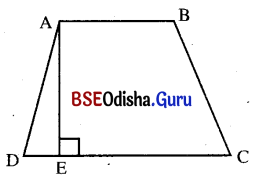

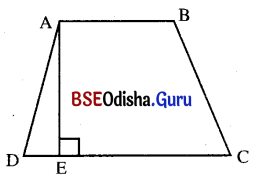

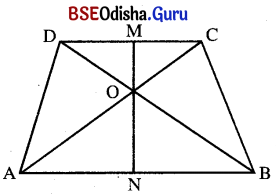

![]()
![]()
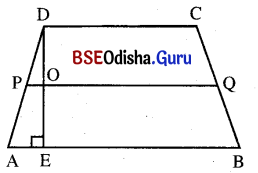

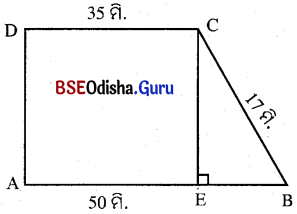

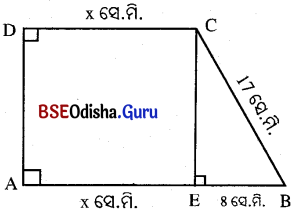

![]()

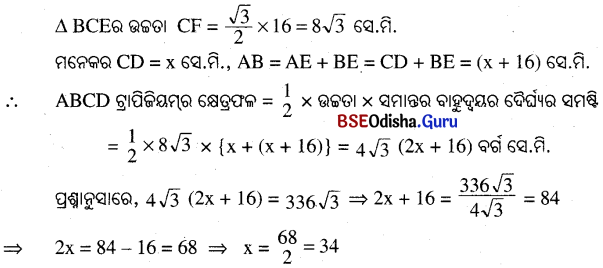
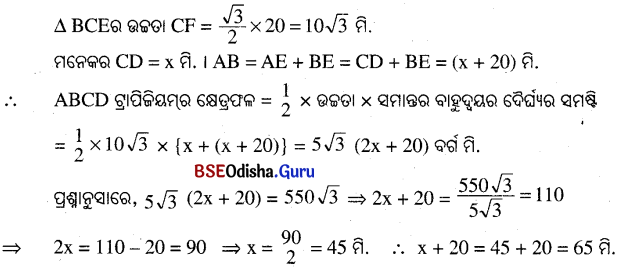
![]()


